Tribute: The creation of this page is a direct result of the catastrophe wrecked on the United States Northeast by Hurricaine Sandy, which extensively damaged both NYU Langone Medical Center and Bellevue — leading to their prolonged shutdown and our secondary over-indulgence in academic productivity. This page is dedicated, in small measure, to all who suffered loss as a result of this unprecedented disaster.
Introduction
The aim of this page is to review the anatomy of the internal carotid artery proper, from the cervical segment to its intracranial bifurcation, particularly as regards its geometry (with secondary endovascular interventional implications) and location of its various, and often complex aneurysms. Patients seeking information on treatment of cerebral aneurysms may visit the page titled “Patient Information: Cerebral Aneurysm“. The author of the website, Maksim Shapiro, MD is a practicing neurointerventional radiologist in at the NYU Langone Medical Center in New York City, and can be reached with questions, comments, appointment requests, etc. via the Contact Us section.
The branches of intracranial ICA are described in exhaustive detail on their respective pages. It would take take hundreds of pages, with associated surgical dissection images and videos, to describe surgical anatomy of the carotid siphon, and so we will touch upon this vast topic somewhat, mainly in connection with strategies in aneurysm treatment. Our primary focus is endovascular, and we will present information in angiogrpahic format, without too many diagrams, which often appear to the trainee so frustratingly comprehensible when compared with reality.
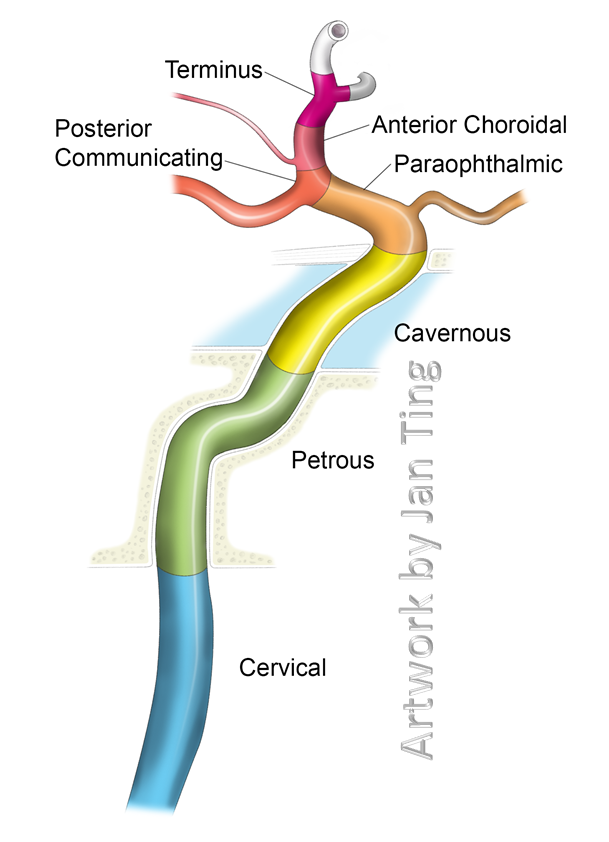
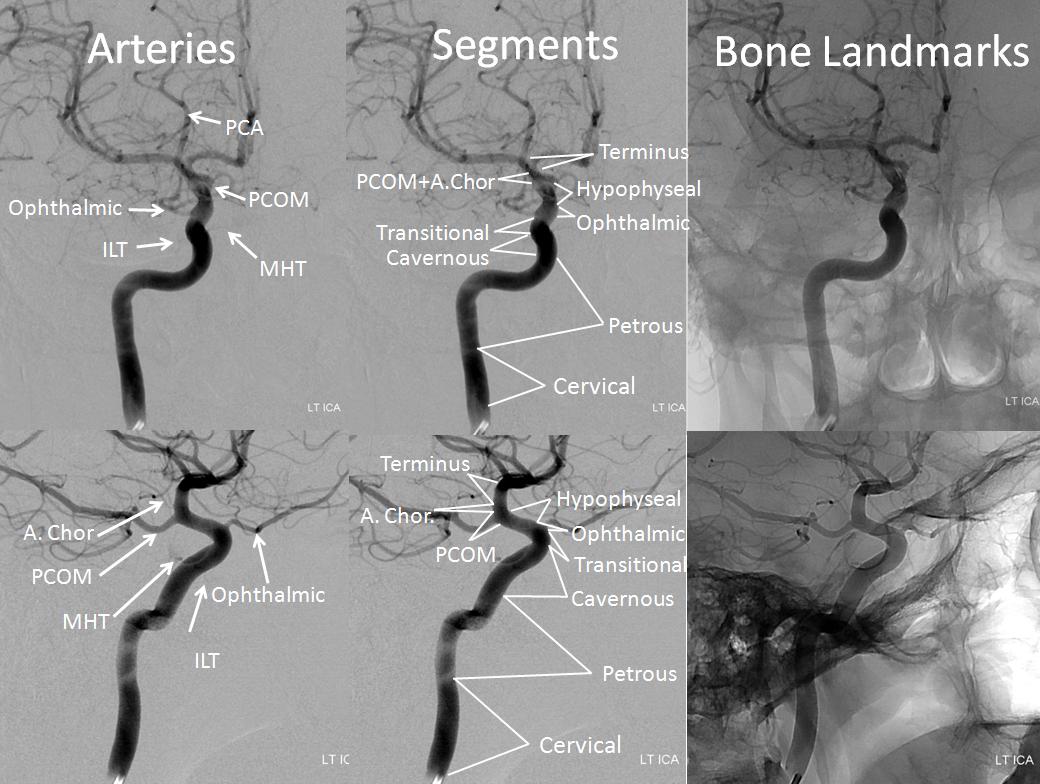
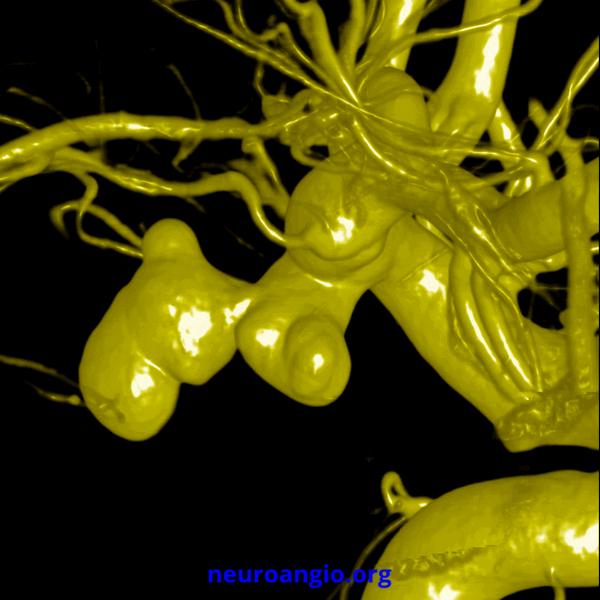
A brief overview of ICA anatomy. The ICA in the neck (cervical ICA) extends from carotid bifurcation to skull base. It then goes through the petrous bone of the skull base (petrous segment), and turns up within the foramen lacerum, existing the bone. It passes under a key landmark structure called petrolingual ligament, and enters the cavernous sinus, where it usually has an s-shaped look, though much variability exists. In the cavenous sinus, the artery is surrounded by venous plexus, such that carotid rupture there leads to a carotid-cavernous fistula. After an anterior turn (genu), the ICA leaves the cavernous sinus, passing through the dura cover of the sinus that is called the “proximal dural ring”. The ICA then goes through a small but important region where, though already out of the cavernous sinus, it is not yet subarachnoid, or intradural. This “transitional” or clinoid area has been subject of much surgical attention. After this short segment, the ICA goes through another dural ring, called the “distal dural ring”, and then becomes intradural, or subarachnoid. This transition is critical, since aneurysms past the “distal dural ring” are located in the subarachnoid space, and their rupture leads to subarachnoid hemorrhage. The ophthalmic artery is usually (90% of time) located just distal to the distal dural ring (i.e. intradural, i.e. subarachnoid), and this region is home to many kinds of complex aneurysms. Other times, the ophthalmic arises more proximally, from the transitional (extradural) or the cavernous segment, or from the external carotid — all very important variants. Past the ophthalmic segment, artery continues into the hypophyseal region (with inconstantly observed superior hypophyseal arteries), where other kinds aneurysms can form. The next major branch of the ICA is the posterior communicating artery, home to particularly notorious PCOM aneurysms, which seem to rupture with increased frequency for given size, when compared to other aneurysms of the ICA (ISUIA data). Next comes the anterior choroidal artery and its aneurysms, which can be mistaken for the PCOM type when the latter is hypoplastic. Finally, after a short terminus segment, home to some perforating branches, the ICA bifurcates into the MCA and ACA. This fairy tale has many variations and inconsistencies, but is useful as a general guide. Now that we have the general layout, before getting into pathology, we must review some segmental classifications of the ICA.
Segmental Classifications of the ICA
The ICA has been repeatedly subdivided into discrete parts, or segments, to aid description of its pathology. We, at NYU, are also to blame for one such scheme. A brief review of the more popular classificatons is necessary and useful for the trainee and lay professional.
The first classification was devised by Fischer in 1938, designating intracranial ICA from C1-C5, against direction of blood flow. Its aim was to help localize skull base lesions via their mass effect on different ICA segments, before the era of cross-sectional imaging. It was not designed to describe ICA aneurysms.
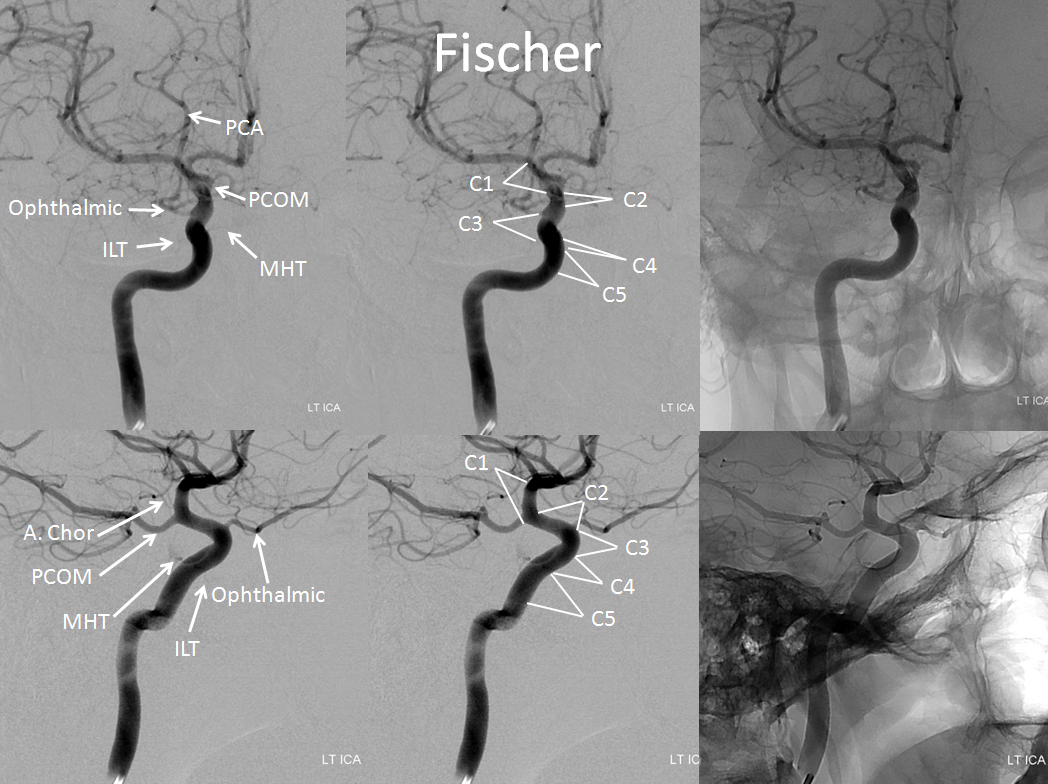
The Fischer classification endured until development of reliable microsurgical and catheter angiographic technique, which paved the way for development of predominantly non-lethal aneurysm neurosurgery.
In 1981, Gibo, Lenkey, and Rhoton, based on incredible supraclinoid ICA dissections which became a landmark in vascular neurosurgery, classified their findings according the the Gibo system, which numbered 4 segments — cervical, petrous, cavernous, and supraclinoid, with an alphanumeric designation of C1 thru C4, in direction of blood flow. The C4 segment is subdivided into ophthalmic, communicating, and choroidal (see below). The C3 segment began wherever the ICA emerged from the dural covers as a subarachnoid vessel. This simple and elegant classification, predating the era of dural rings and clinoid discussions, continues to be in use.
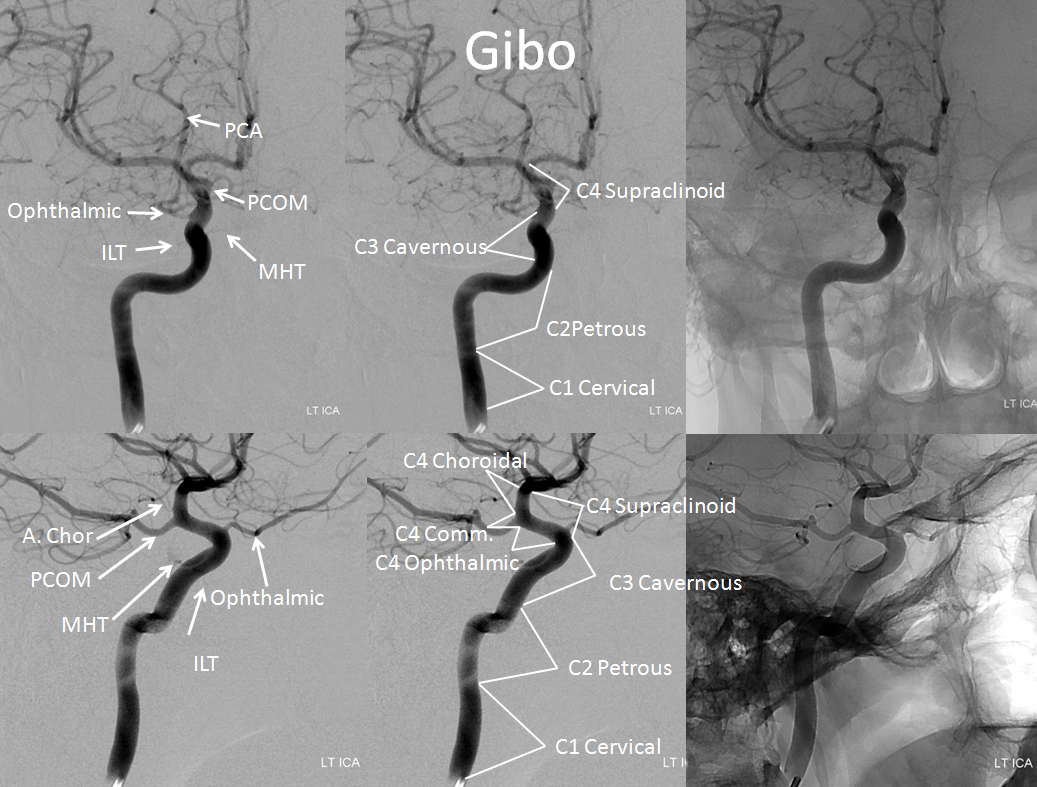
The landmark present-day classification, however, belongs to Bouthillier and collegues, who proposed a “Modified Fischer Classification” in 1996, with alphanumeric designation of ICA segments in direction of blood flow. This system was also based on careful microsurgical dissections and optimized for present-day aneurysm clipping. Importantly, it formally recognized the “clinoid segment” as a transitional area between the cavernous and intradural ICA, as will be discussed below.
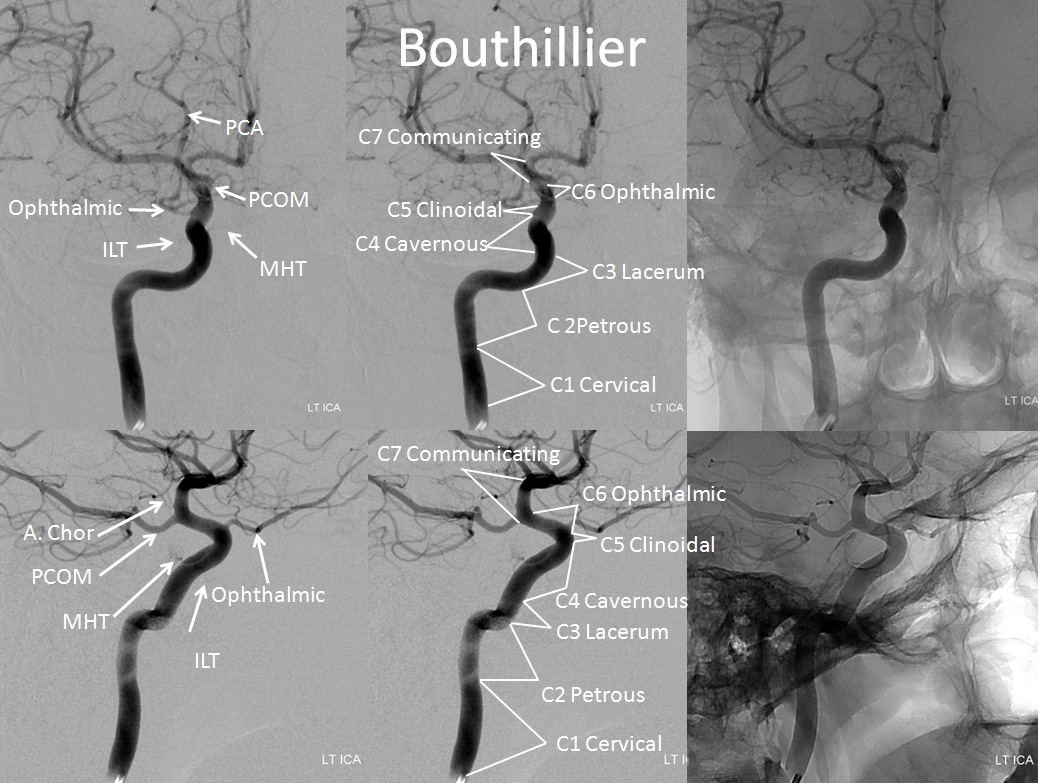
The Bouthillier classification was widely adopted, despite some criticism. For example, Ziyal and collegues questioned the need for a discrete Lacerum Segment, and dispensed with it based on their careful dissections. They also got rid of the ophthalmic and communicating segments, in favor of simple “cisternal segment”. This classification, shown below, did not achieve widespread use.
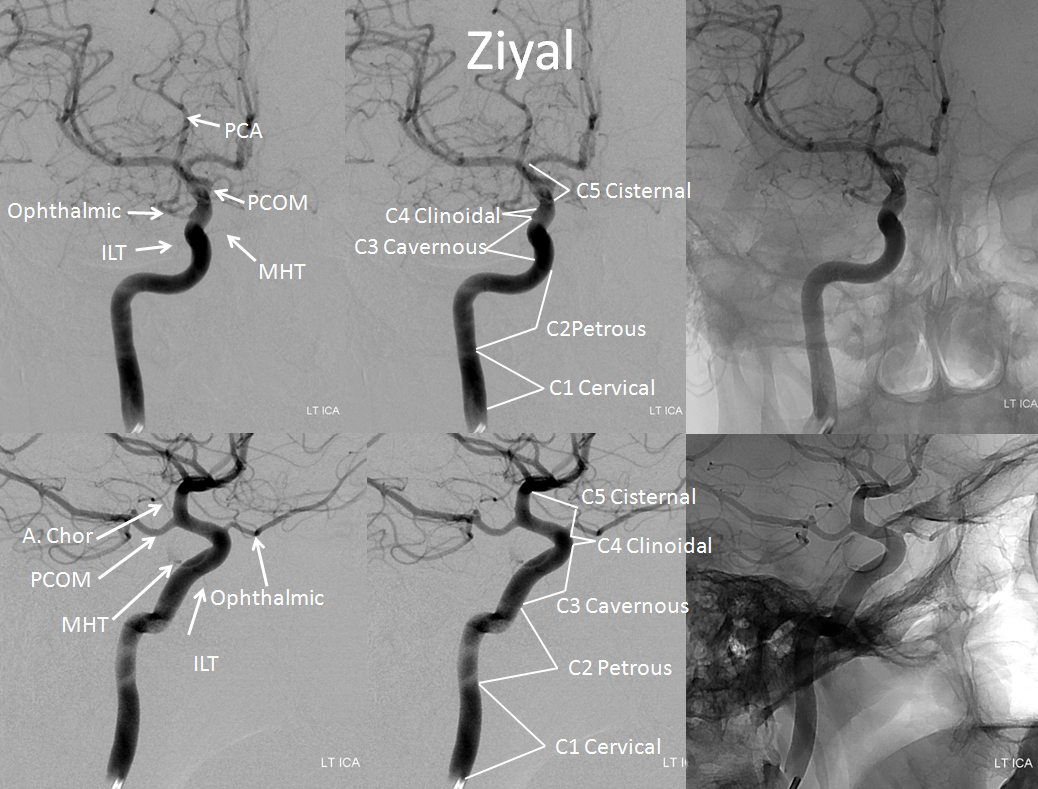
An entirely different approach was taken by the great Lasjaunias who, together with Santoyo-Vazquez, subdivided the ICA based on embryologic considerations rather than anatomical landmarks adjacent to the ICA. The article is available free of charge: http://link.springer.com/article/10.1007%2FBF01773165?LI=true#page-1 Segment boundaries were defined by intracranial ICA branches, such as mandibulovidian artery, MHT, ILT, ophthalmic. This system makes the most physiologic sense, and conceptualizes many variants of the ICA and its branches, but it was not designed to facilitate surgical dissections or emerging endovascular methods.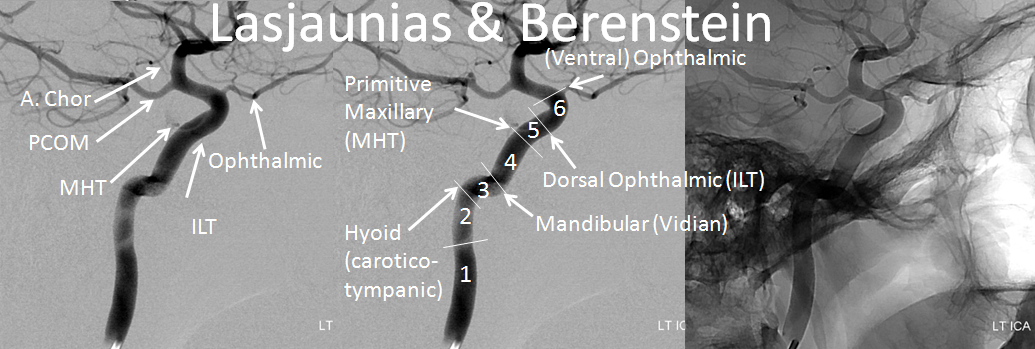
Much surgical work was done to address the complex anatomy of the ICA surrounding the region of the anterior clinoid process, including the transitional segment between the cavernous and intradual ICA, and the various ophthalmic segment aneurysms. Surgery which required removal of the clinoid process was rather complex, and aneurysms within the cavernous segment were regarded by many as either “unclippable” or clippable given superb skill and acknowledgement of higher stakes. Work on aneurysms near the ophthalmic artery (and optic nerve) was associated with a well-known risk of visual loss. At the same time, more reliable endovascular techniques were emerging with introduction of the GDC. This modified the conceptual framework, emphasizing aneurysm dome morphology and neck anatomy, with less critical attention to surgical landmarks. Finally, emergence of primary endoluminal (flow diversion) methods allowed for treatment of the underlying ICA dysplasia, which often transcends artificial segmental boundaries. Our own NYU classification of ICA segments, developed as a result of angiographic and cross-sectional review and discussion, is based predominantly on endovascular considerations.
Finally, it is not the purpose of this page to advance a particular classification: the object is to illustrate the anatomy and pathology of the ICA; the NYU classification is used because we find it most useful at the moment — as long as there is understanding of whatever anatomy the classification describes, any scheme is fine. For classical descriptive purposes, one can use the following system:

From an endovascular standpoint, however, we find that aneurysms which lie on the Transitional-Ophthalmic-Hypophyseal continuum have particular common endovascular (rather than surgical) features, which unite rather than divide them, as has been previously the case. We therefore hold, somewhat boldly, that all of these can be considered as “paraophthalmic”. This is not the system in current use, though we hope it gains following, which would look something like this:
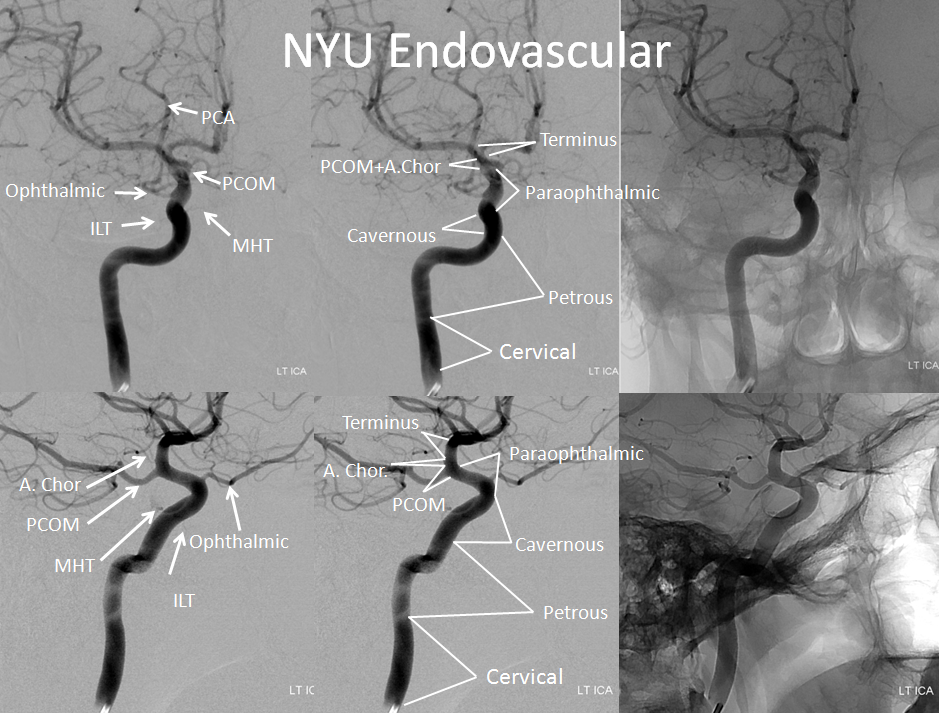
This is nicely illustrated in the artwork below:

In the following section, each segment is discussed in more detail, and relevant aneurysms are shown.
A note regarding aneurysms: The following section will repeatedly emphasize a key point: aneurysms in general, and those of ICA in particular, are not perfect spheres with slender, elegant necks — these can be encountered in diagrams, pamphlets, and other works of art — and safely cured with a permanent marker, at zero risk. Real aneurysms tend to be irregular growths which arise on basis of underlying ICA dysplasia, and frequently transcending arbitrary and even embryologically-dictated boundaries. Images in this section will direct one towards recognition of this state and its therapeutic implications.
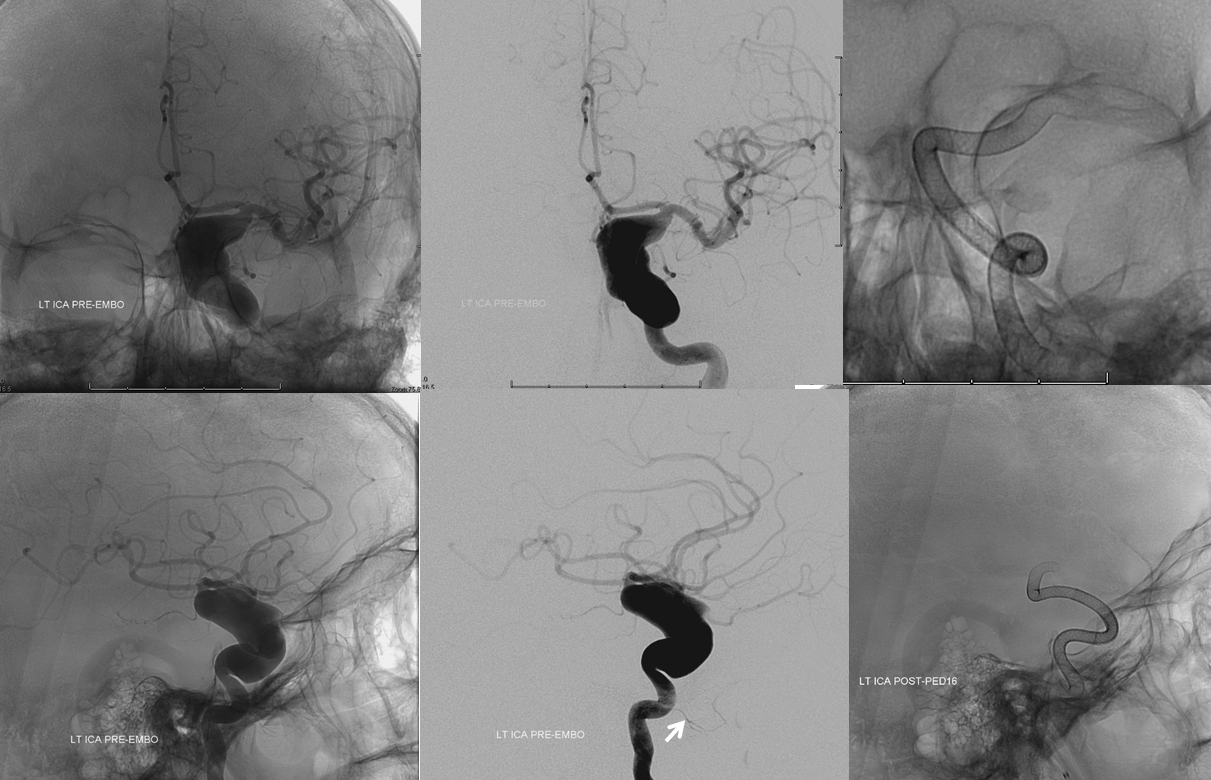
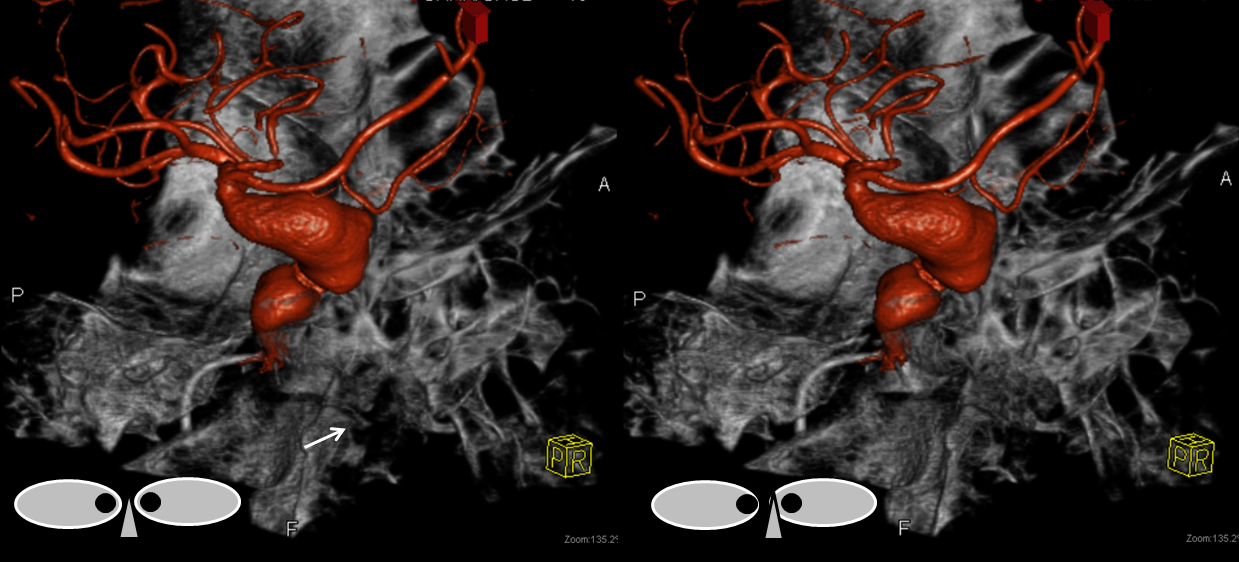
Cervical Internal Carotid Artery
The carotid artery usually bifurcates between C3-5, except when it does not. High bifurcations are disadvantageous for vascular surgeons but not for carotid stents per se.
Atherosclerotic disease of the carotid bifurcation and its treatment is a separate topic. It is potentially important in terms of accessing the internal carotid artery with large-diameter catheters, increasingly utilized in modern endoscular procedures. In such cases, we try to keep the exchange wire in the ECA, and bring the guide into the ECA as well and flush it there, or keep it in the CCA, and go through the stenosis with a smaller profile and more compliant distal support catheter (these catheters are getting better and more numerous, which is excellent news). If additional support becomes necessary later on, the guide can then be more safely advanced into the internal carotid artery over the larger diameter distal access catheter, rather than primarily over a smaller cross-section guidewire, thereby minimizing the “step-off”
The cervical internal carotid artery is supposed to have no branches, except when it does. Persistent hypoglossal artery is one such branch (See neurovascular evolution). The ascending pharyngeal artery occasionally takes off from the proximal ICA also, as does the occipital. Aside from embryologic implications, it underscores the potential costs of catheterizing the ICA without a roadmap, which is also useful to visualize the not so rare Cervical Internal Carotid Artery Loops. They are felt to represent a kind of embryologic redundancy, which can also be observed intracranially involving the PCOM and A1 segments for example (Lasjaunias and Berenstein) — as opposed to the tortuous vessels seen in the vasculopaths.
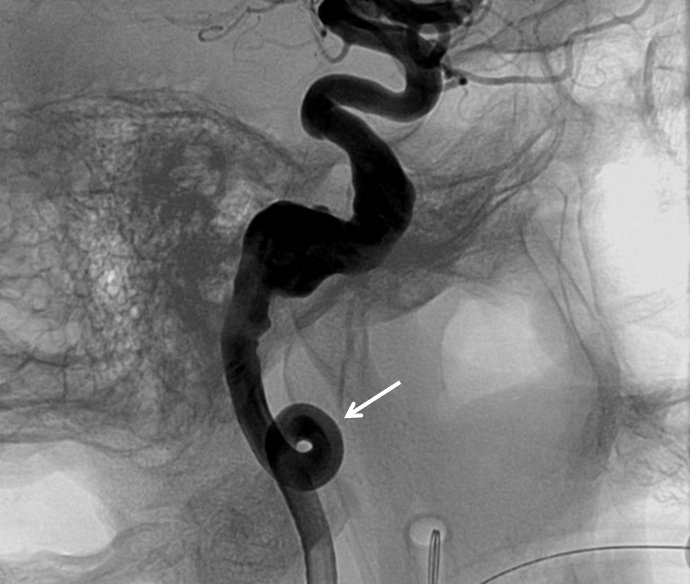
Loops are, of course, significant from an endovascular access standpoint, presenting challenges for distal catheterization and delivery of larger caliber devices. This is fortunately becoming less problematic, as distal support catheter technology rapidly improves.
Retropharyngeal ICA: Distinct from loops are carotids with unusual courses, particularly those that swing anteromedially towards the back of the oropharyngeal wall, best appreciated on cross-sectional imaging. They are surgically important, particularly when it comes to procedures related to the posterior nasopharyngeal and oropharyngeal walls. A pulsatile mass in the back of the throat is probably the ICA, and should be treated with appropriate respect.
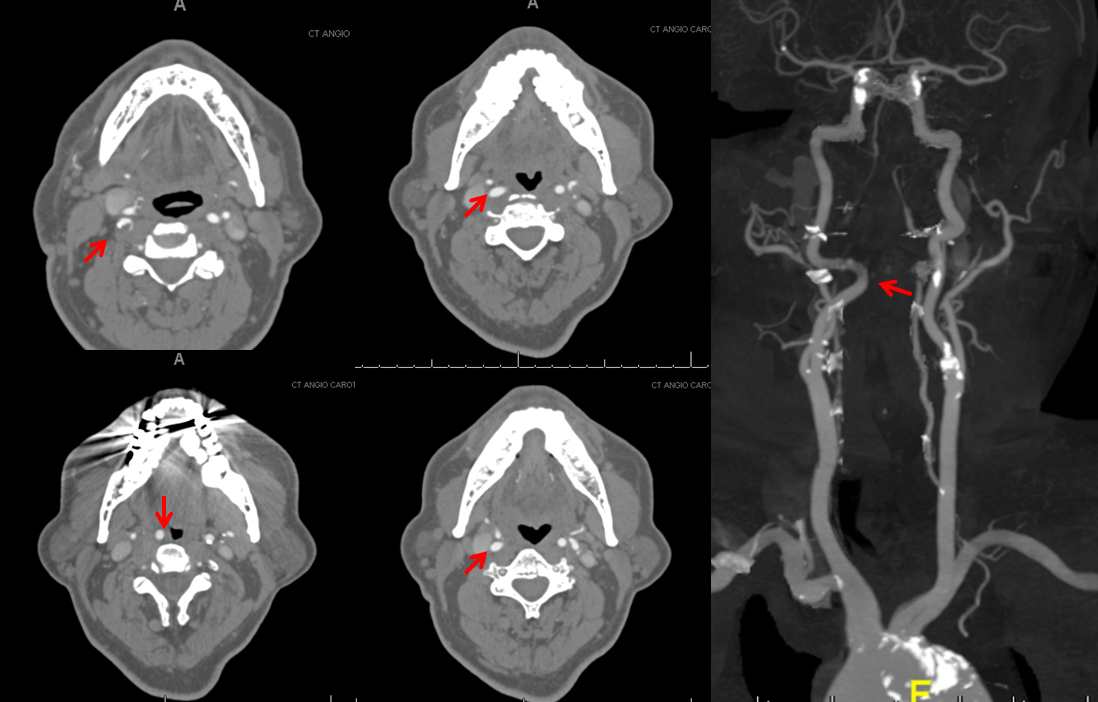
Webs — the cervical ICA, in particular its proximal aspect, are sometimes seen to harbor a particular narrowing which is caused by shelf-like proliferation of connective tissue, probably similar to that of fibromuscular dysplasia (FMD). The angiographic appearance is very different, however, with a single shelf of stenosis. This can be occasionally a cause of embolic stroke due to blood stasis over the shelf, more likely than hemodynamic narrowing. This young man presented with a transient language dysfunction:
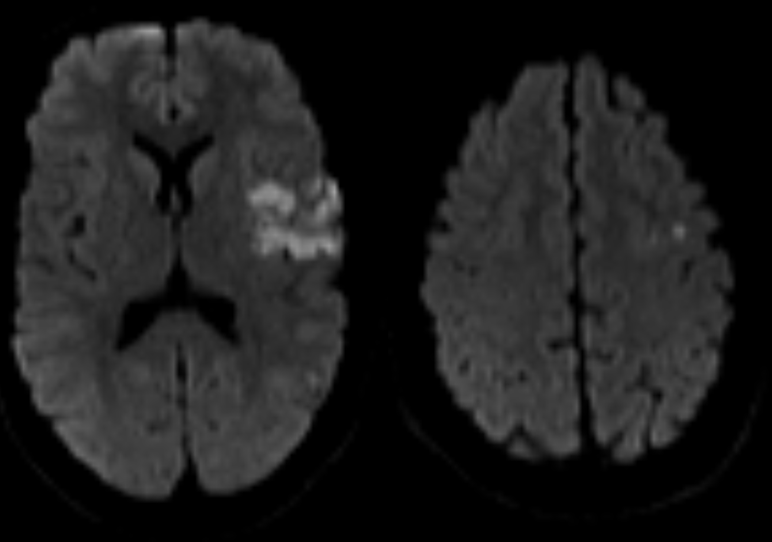
MRA and angio of the same patient, left ICA. A second patient, with a similar angiographic appearance of carotid web, noted incidentally. For more info, see dedicated Carotid Web page
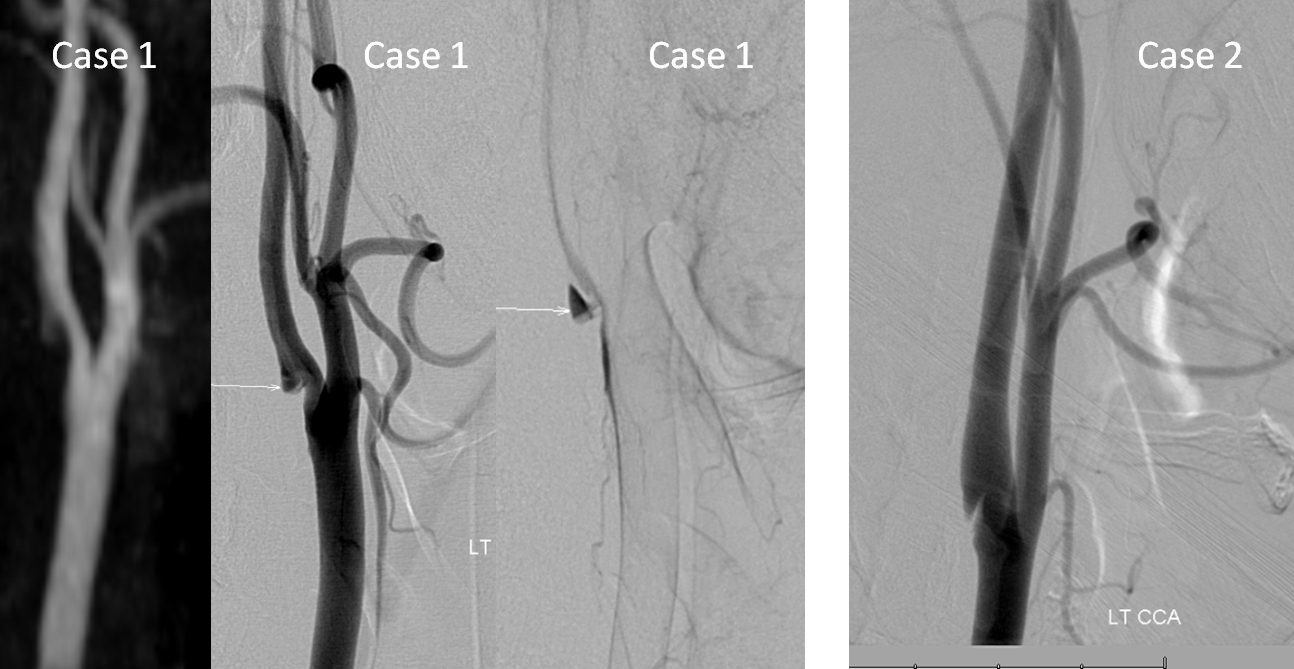
Aberrant Carotid Artery — fully treated in the Ascending Pharyngeal Artery Section, as this vessel is, in fact, not the “ICA”, but rather ascending pharyngeal reconstitution of the true ICA in the petrous segment, due to cervical ICA agenesis. The aberrant carotid is made up of the ascending pharyngeal artery, its inferior tympanic branch, and the caroticotympanic branch of the ICA. The vessel has a characteristic lateral swing within the petrous bone (red arrows), bringing it into the middle ear cavity, which can be appreciated on MR, CT, and angio. This variant comes up with unfortunate regularity as a middle ear “pulsatile mass”, subjected to an unwitting biopsy. Case courtesy of Dr. Howard Antony Riina, NYULMC
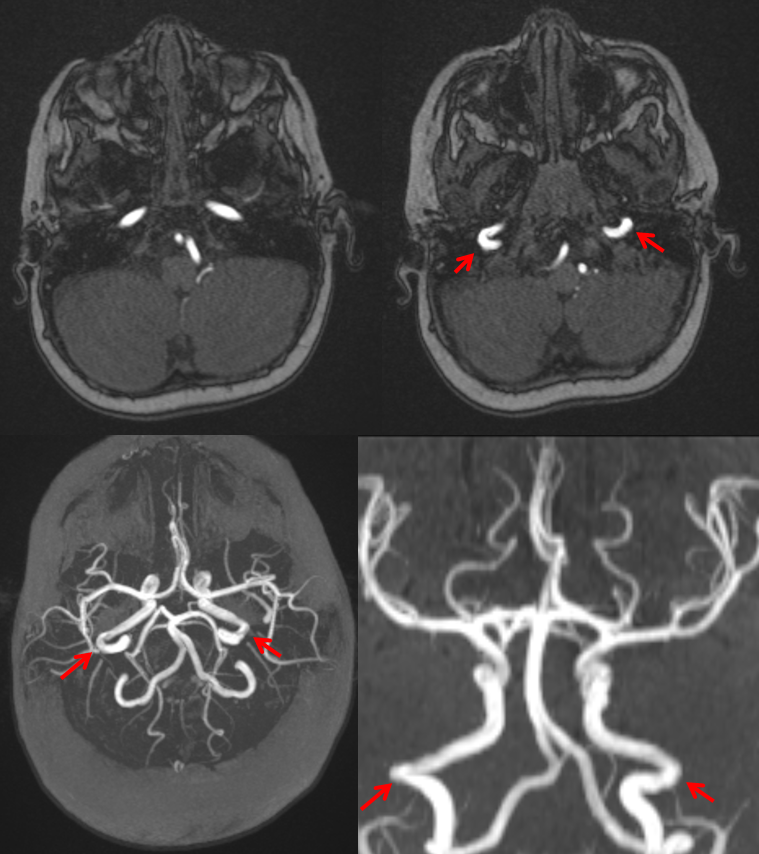
The same appearance angiographically, with a somewhat posterior course in the lateral projection (yellow arrow)
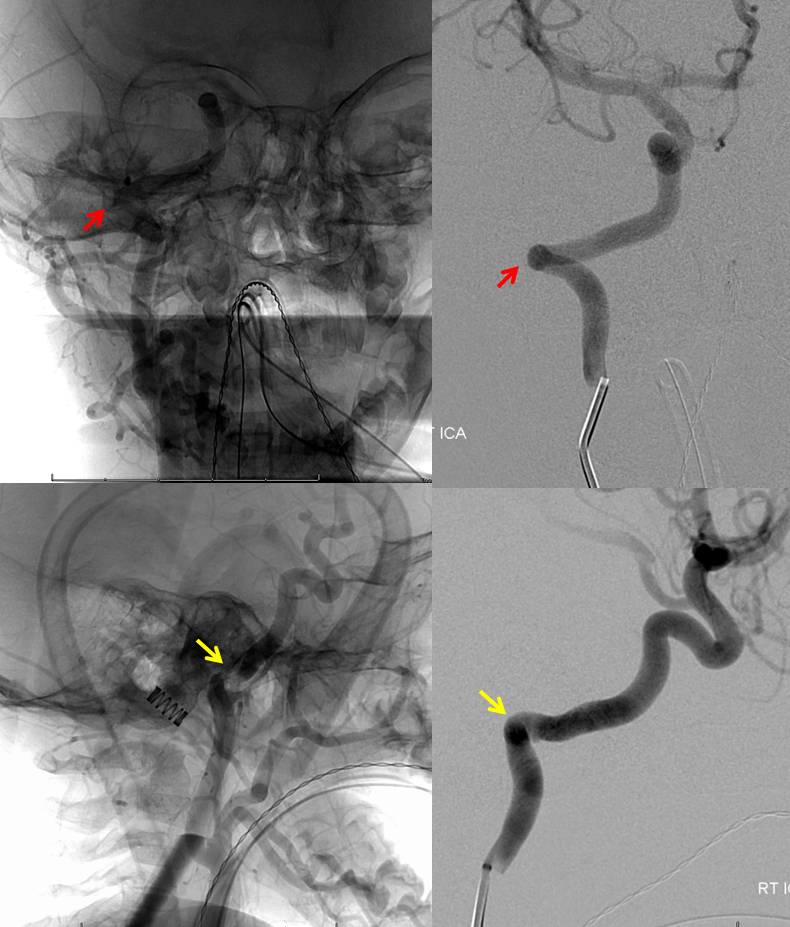
Finally, a VERY cool stereo 3D-DSA, visualizing the aberrant ICA within the ear canal.
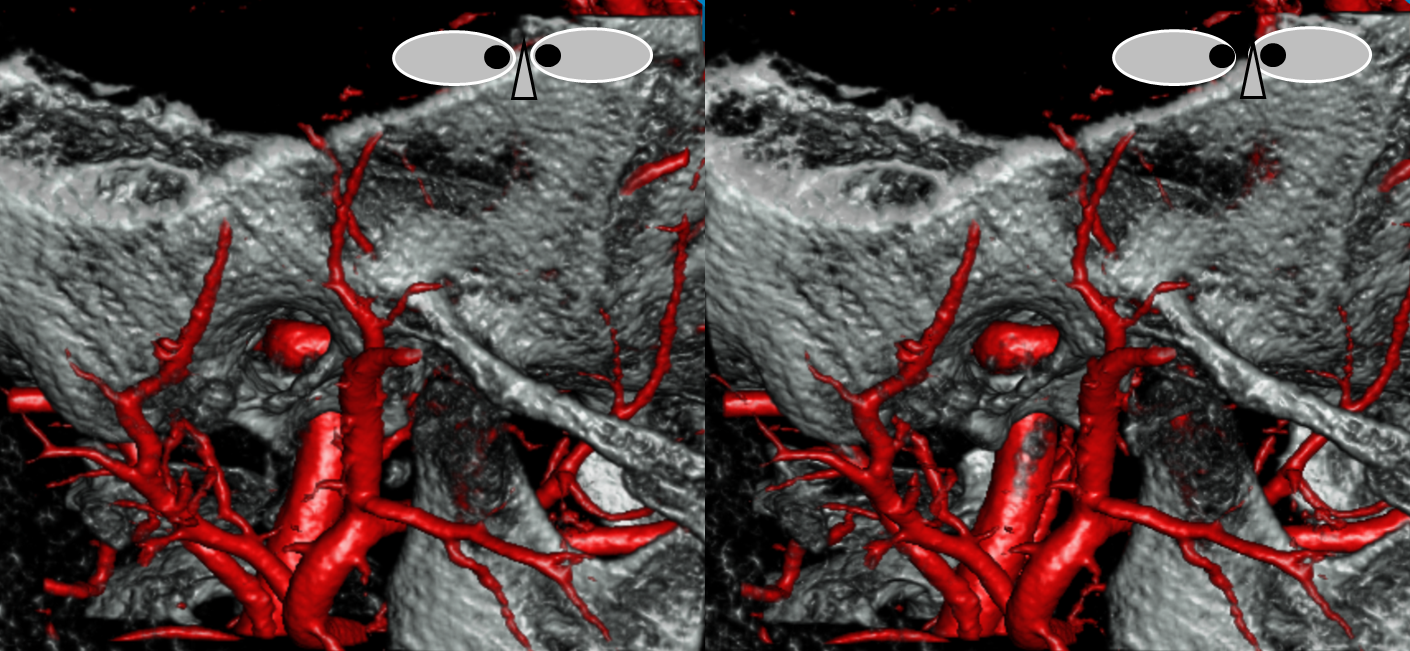
Adult example aberrant carotid — Courtesy Dr. Todd Miller, Stamford Health
You don’t even need contrast to see an aberrant carotid on high-res CT such as t-bone or thin section helical CT like this one. The path through temporal bone, and over the cochlear promontory (arrows) is really obvious. Below is a pre-contrast mask of a CTA
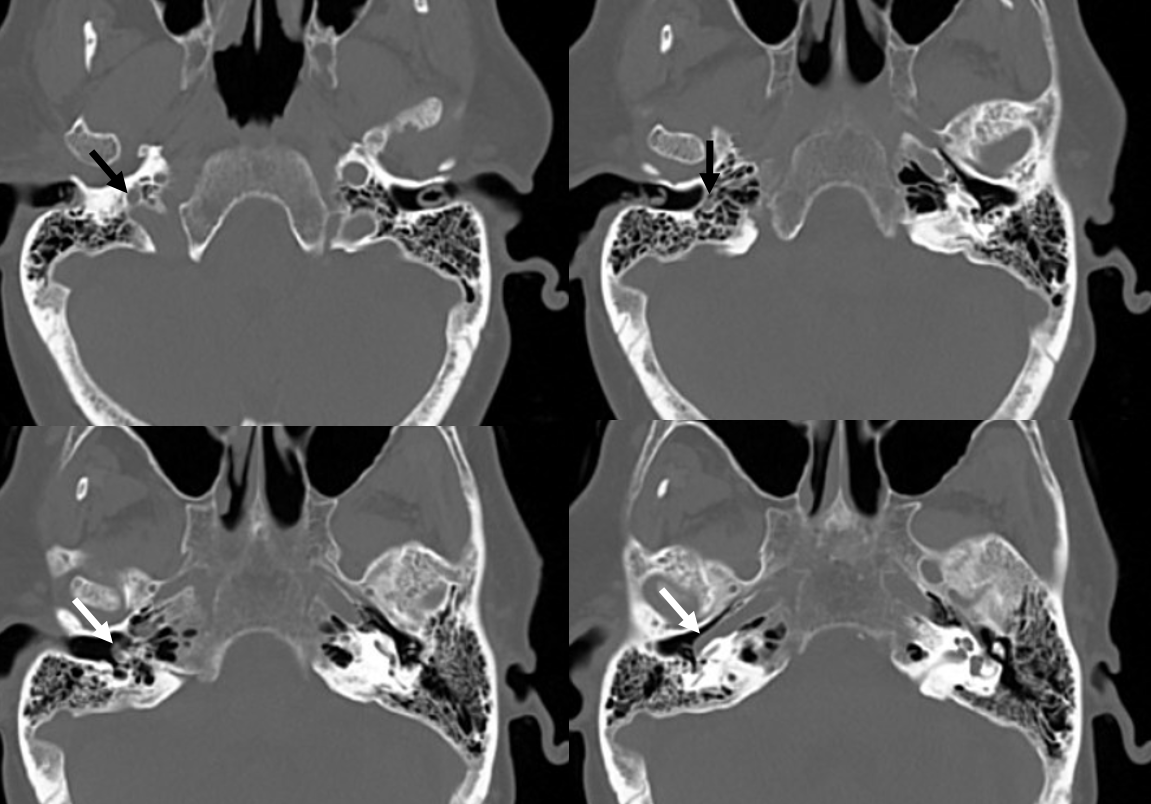
post contrast images are below — really the precontrast ones are just as good for diagnosis
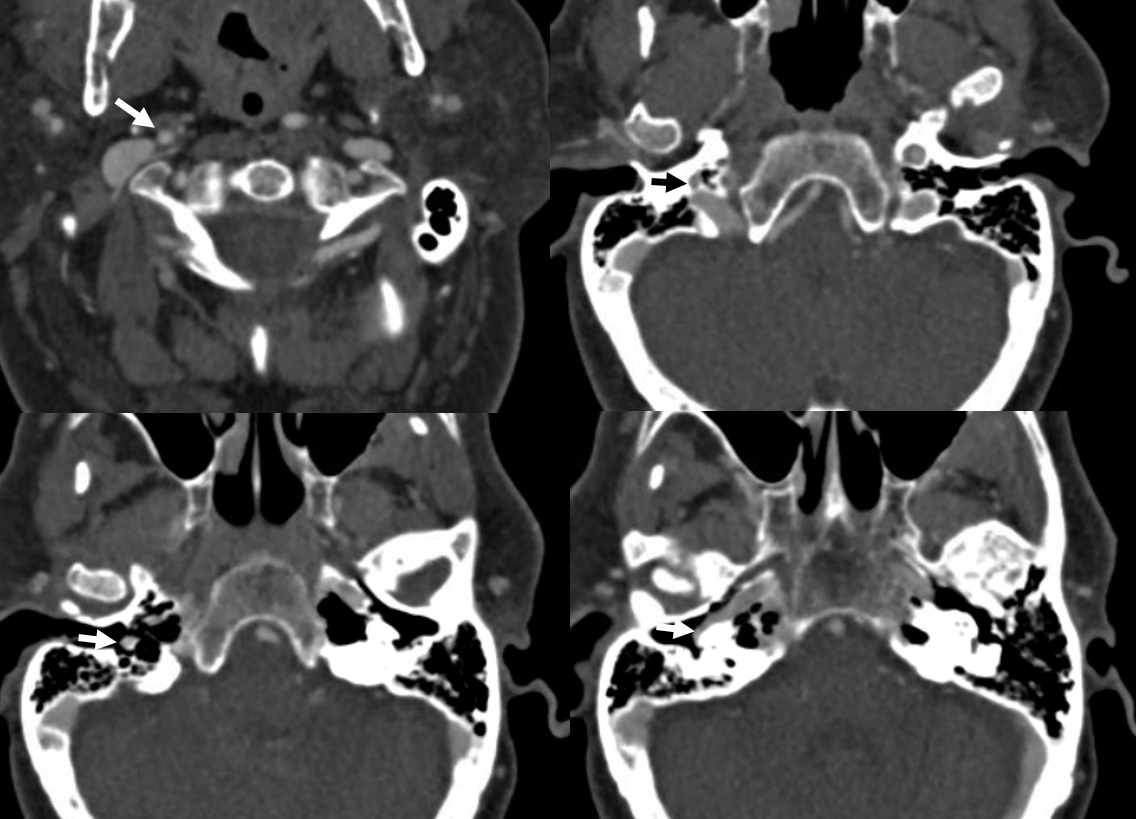
Caroticotympanic Branch
Normally very small and essentially impossible to see on DSA due to dense petrous bone overlap, it is often seen with high quality cone beam CT techniques (arrows, below)
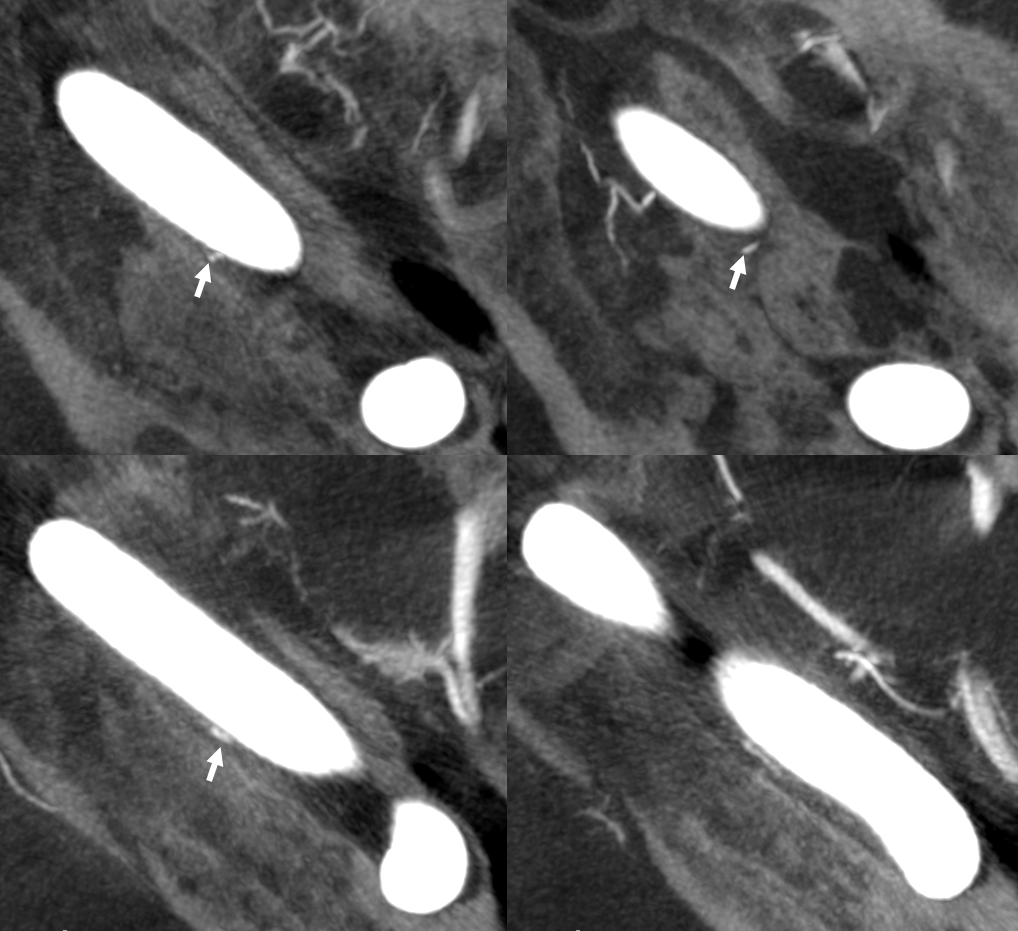
Carotid Occlusion — Vasa Vasorum Reconstitution
An occasionally seen, quite fascinating consequence of carotid occlusion. Since all tissues require blood supply, it stand to reason that walls of larger blood vessels, such as the aorta and carotid arteries, contain smaller arteries for the nourishment of the various connective, muscular, and other tissues which make up the wall. These are called Vasa Vasorum. On some occasions, occlusion of the primary carotid artery lumen is followed by hypertrophy and, possibly, hyperplasia of these vasa vasorum to reconstitute the carotid artery distal to the site of occlusion. When encountered, these vasa vasorum networks tend to be long, extending from the carotid bulb (usual site of atheromatous occlusion) to the pertous segment, where the native carotid artery is again opacified. This pathway is likely to be present only when the more typical collateral pathways (circle of Willis, ophthalmic artery) remain insufficient (see Collateral Circulation page for extensive discussion on the topic). Below is a typical example of carotid vasa vasorum (red) — a tortuous channel or multiple channels, having no resemblance to the native lumen. A normal petrous carotid is artery is labeled (yellow).
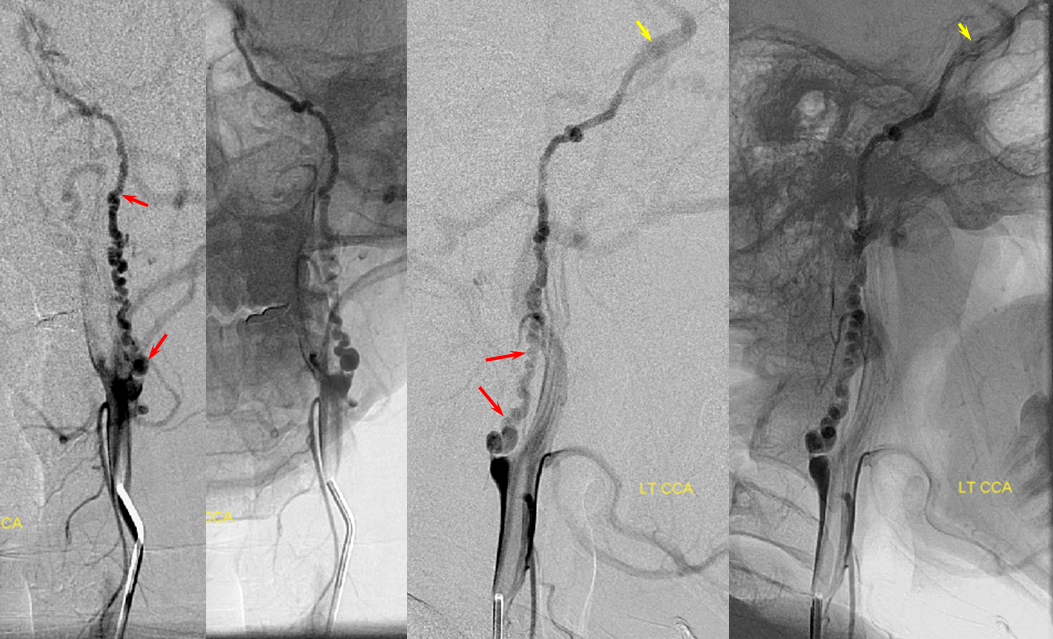
Another example, with a duplicated channel (pink)
Aneurysms
In cervical ICA, these are typically of dissecting type, and therefore pseudoaneurysms (white arrow), such as this one.
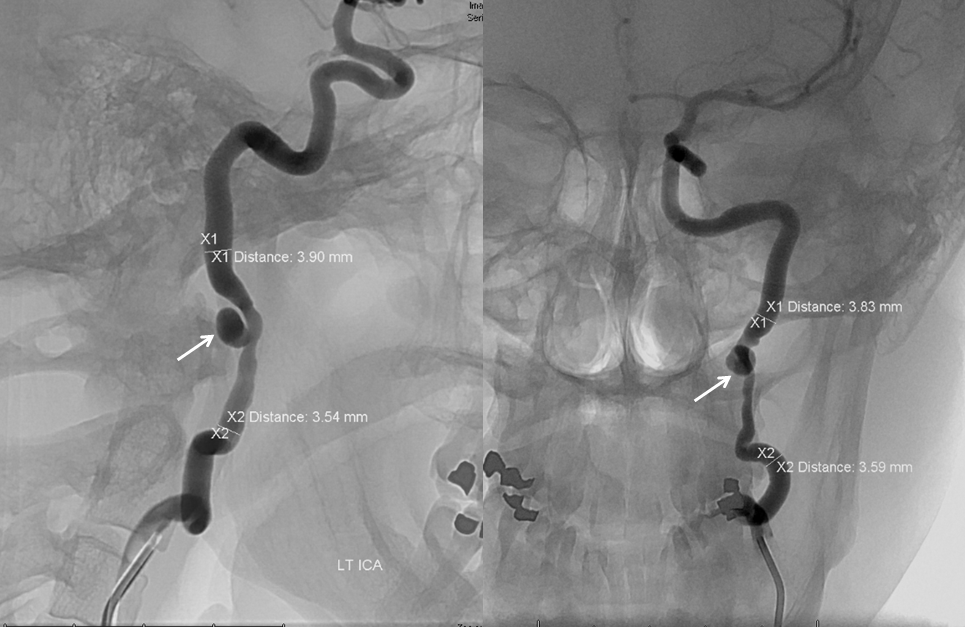
Dissecting aneurysms are a heterogeneous bunch. Many seem to be either asymptomatic or clinically benign, generating much harm in terms of patient anxiety but little beyond that. They can, when particularly large, act as embolic sources.
Carotid Dissection
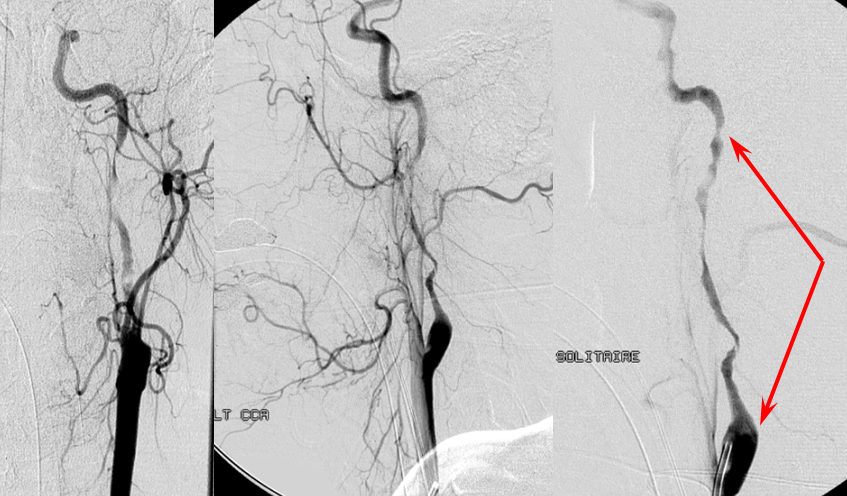
This is an important topic, addressed in a dedicated “Patient Information Carotid/ Vertebral Dissection” page. While most carotid dissections do not lead neurologic dysfunction, a fact which patients should remember, the range of occasional issues is large, including embolic stroke from dissection-related thrombus formation and distal embolization, flow-limiting stroke due to insufficiency of distal collateral pathways, and occasional rare issues such as pulsatile tinnitus or lower cranial nerve dysfunction due to dissection-related mass effect.
Petrous Segment
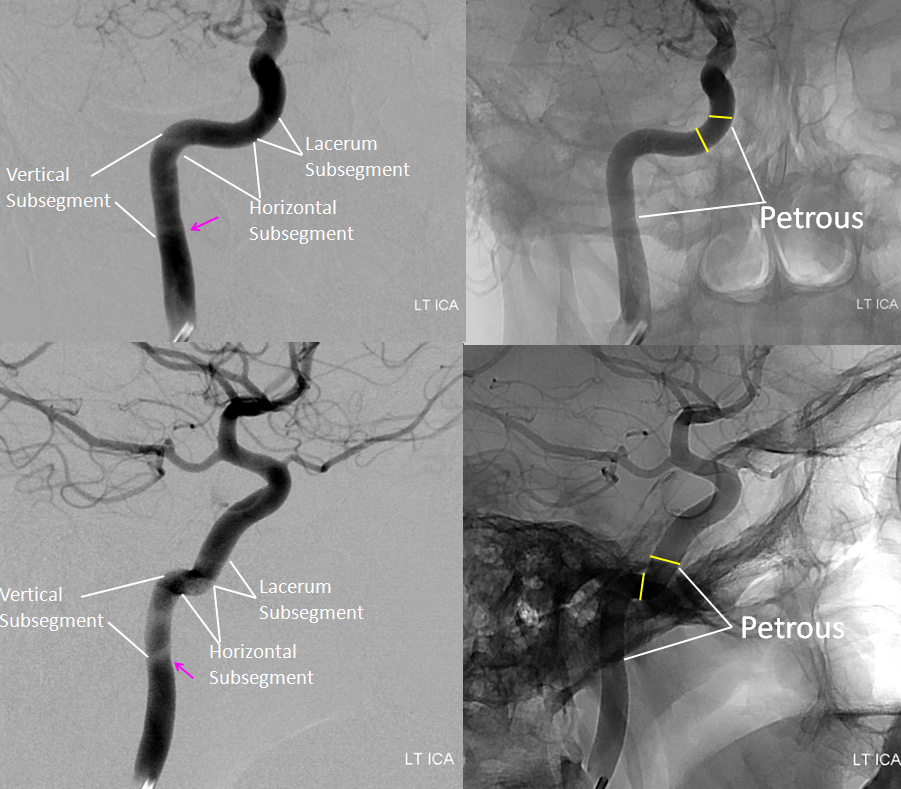
Petrous segment — This is the ICA segment inside the petrous bone and partially within foramen lacerum. The artery enters the skull at right angle and has an initially ascending course (vertical petrous subsegment), turning anteromedially (horizontal petrous subsegment) and exiting the petrous bone at foramen lacerum, where it turns up and travels a short distance before issuing from the foramen above the horizonal plane of the petrous bone (lacerum subsegment). At this point, it passes beneath the Petrolingual Ligament (PLL), an important landmark which defines entry of the ICA into the cavernous sinus (cavernous segment). The PLL cannot be angiographically seen, and the plane of the temporal petrous bone can be taken as its landmark (distal yellow line). As everyone knows, the ICA does not go thru and thru the foramen Lacerum, but runs into it, as T-intersection. Bouthillier defined a discrete Lacerum segment where the ICA ascends in foramen lacerum. The existence of this discrete segment was questioned by Ziyal. We agree that a separate lacerum segment does not seem to be necessary, both anatomically and pathophysiologically, as aneurysms of the petrous segment almost always extend into the Lacerum portion of the ICA, but very rarely beyond the PLL. There is much variability in the lengths and angles of the petrous segments. At the genu between the vertical and horizontal segments, the ICA gives off the caroticotympanic branch, which courses posteriely towards the middle ear (this is the route aberrant carotid takes to hook up with the petrous carotid). This branch is rarely seen, as it is encased in thick temporal bone. At the distal horizontal petrous segment, before the artery heads superiorely into the lacerum (or transitional) segment, it gives off the mandibulovidian artery, which courses anteriorly through the vidian canal. A small waist (pink arrow) is sometimes seen where the artery enters the petrous bone.
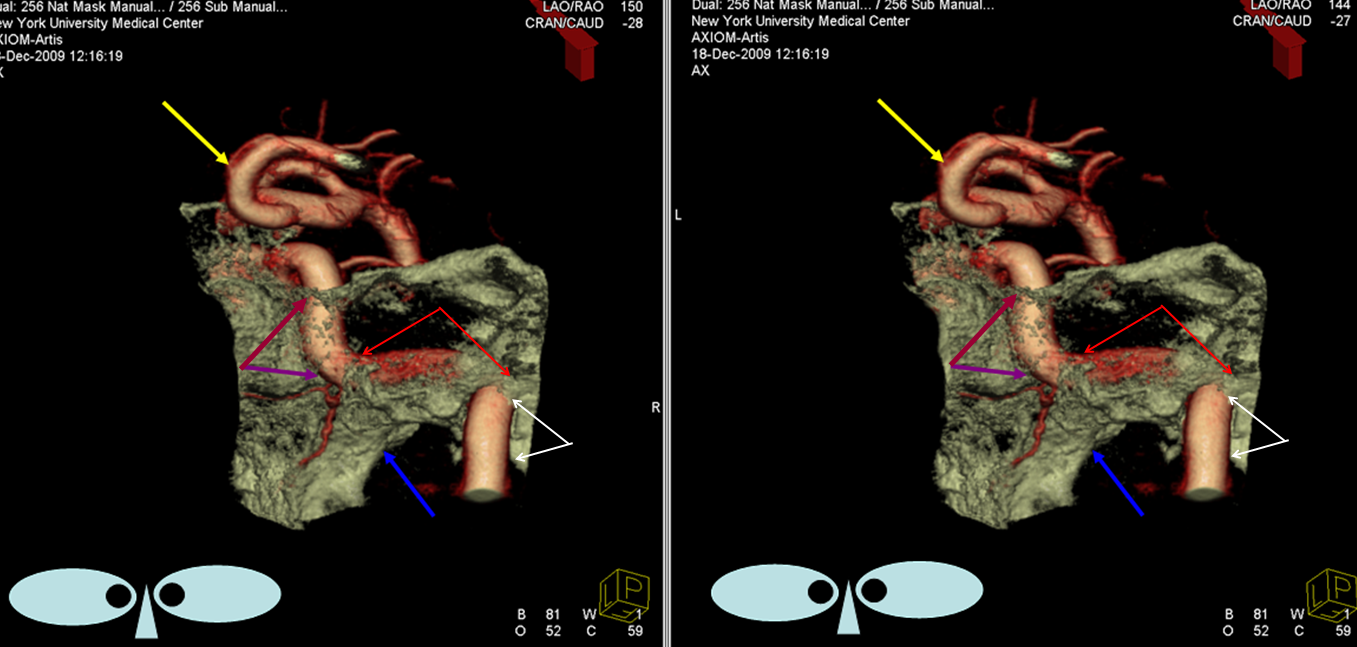
Stereo 3D-DSA of petrous ICA. Short horizontal segment (white), vertical segment (red), lacerum subsegment (purple) and mandibulovidian artery (lower purple arrow) bifurcating into mandibular and vidian branches.
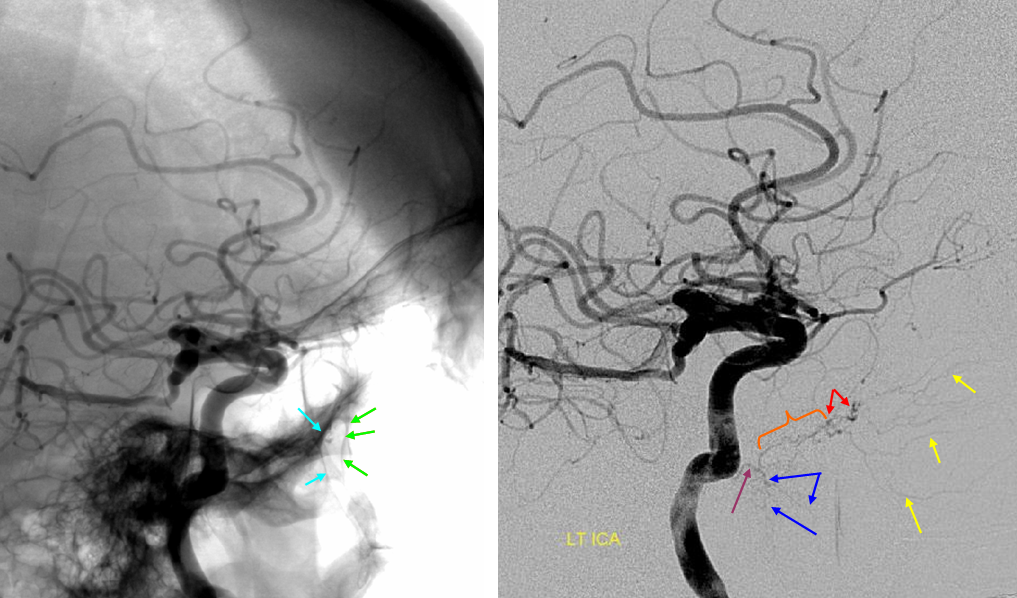
Purple arrow demonstrating a small mandibulovidian artery. Notice how the petrous carotid often appears somewhat attenuated and mottled due to overlap of the petrous bone, compared with the uniform dark color of the cervical and cavernous segments — not to be confused with thrombus.
Petrous Segment Aneurysms
Aneurysms of the petrous segment seem to come in two types — post-traumatic and “other.” Post-traumatic (not aneurysms but pseudoaneurysms) are usually created by skull base fractures involving the temporal bone, with secondary petrous segment tear/dissection/pseudoaneurysm formation. The “other” category usually looks like fusiform large/giant petrous bone blowout, often partially thrombosed, and often extending into the cervical ICA but rarely past the PLL into the segment. When the bone is often extensively remodelled, attesting to long-standing anerysm presence, and the abnormality is easily appreciated on a non-contrast head CT. In my experience, most patients or parents cannot recall any impressive head trauma. Patients with such long, irregular, and partially thrombosed aneurysms can present with an embolic stroke. Historically, treatment was based on a deconstructive approach of carotid sacrifice, with or without bypass, depending on results of test occlusion. Now, many such cases are being treated with Pipeline or similar endoluminal devices.
Illustrations:
Frontal (top) and lateral (bottom) projection digital subtraction angiographic (DSA) and native images demonstrate a fusiform aneurysm involving distal cervical and petrous segments. The long-standing aneurysm, partially thrombosed, produced extensive remodeling (yellow arrows) and erosion (red arrow) of the petrous bone, with bowing of the posterolateral right sphenoid sinus wall and dehiscence of lateral petrous apex (red arrow); status post pipeline embolization. A coil mass in the posterior fossa (black arrows) also seen on CT scan, belongs within a dissecting aneurysm of the mid-basilar artery (purple arrow), also treated with Pipeline (rightmost three images); coils were placed into the aneurysm after documenting its rapid short-term expansion in a patient presenting with new headaches. The case highlights an innate predispostion for aneurysm formation in this patient population.

This incidentally discovered petrous segment aneurysm, with secondary osseous remodeling (yellow arrows), is associated with dorsal ophthalmic artery variant (red arrows), which I believe also supports the notion of a congential predispostion; there is no history of trauma.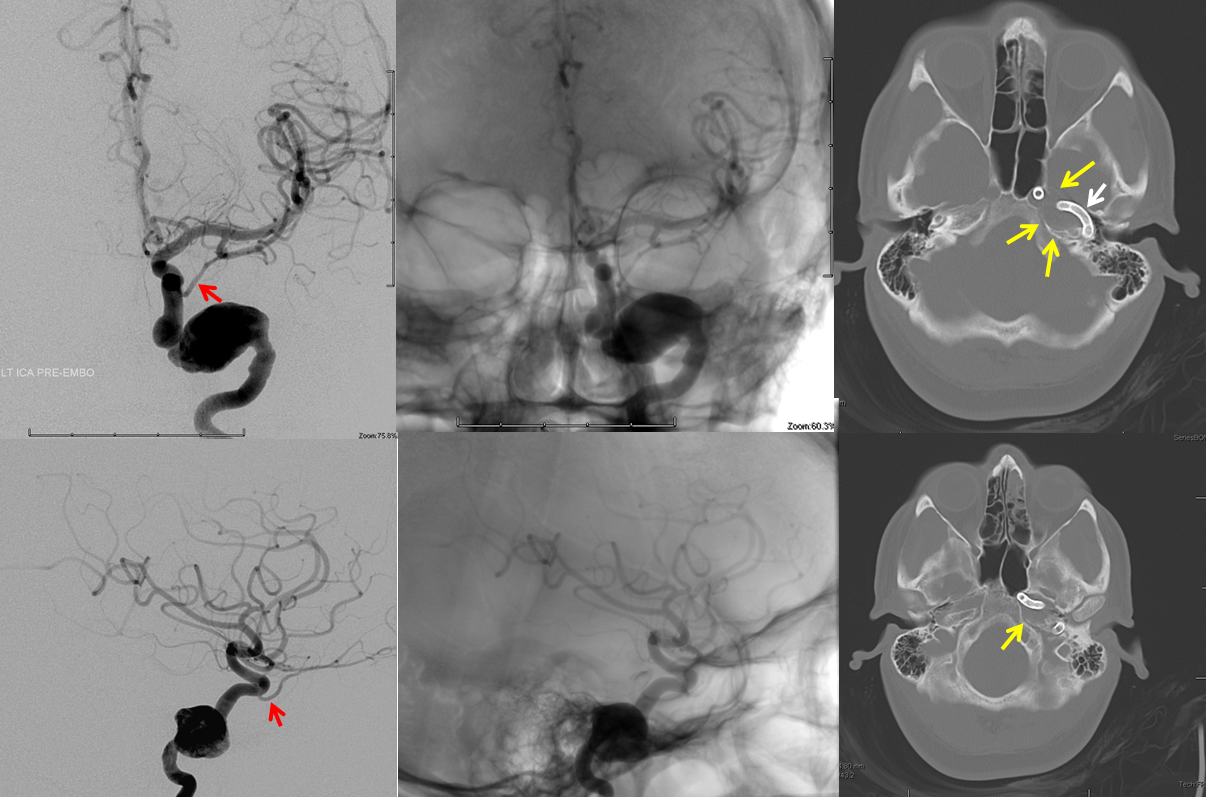
Three petrous segment aneuyrsms, all extending into the lacerum subsegment, but not distal to the petrolingual ligament, as landmarked by the horizontal plane of the temporal bone (white arrows). This is the pathophysiologic side of argument against a separate Lacerum segment.
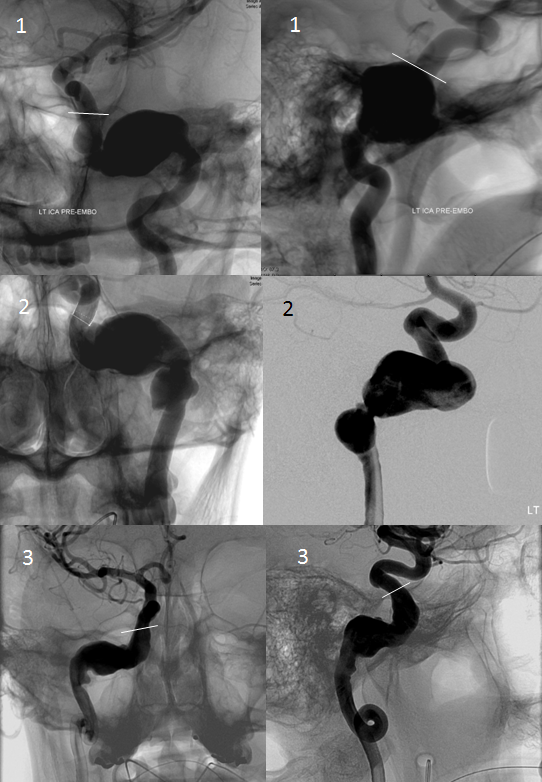
3D-DSA of petrous segment aneurysm, confined below the PLL.
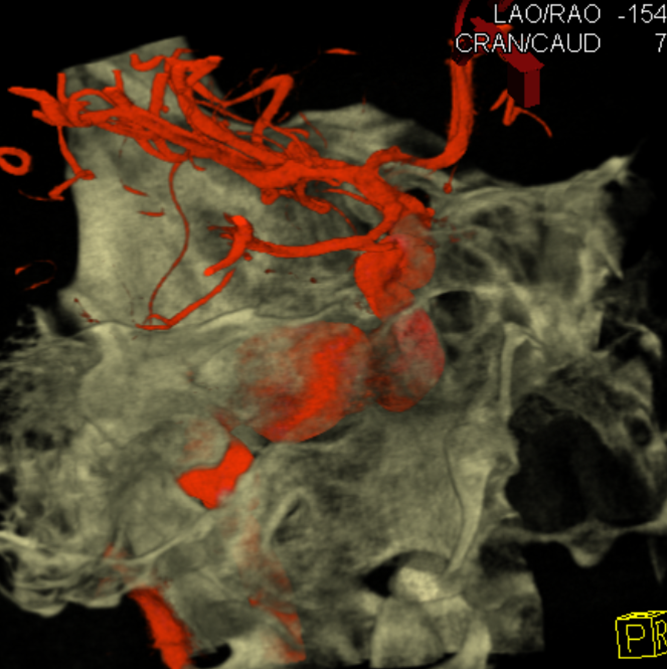
A mirror image of giant “holo-Fischer” aneurysm which involves all post-petrous carotid segments, and also does not violate the PLL. Poster case for trans-segmental dysplasia. A small mandibulovidian artery (white arrow) is seen.

CAVERNOUS SEGMENT

Defined as that portion of the ICA located within the cavernous sinus — see dedicated Cavernous Sinus page for more venous details. In practice, the anatomy of Cavernous Segment is dependent on size and morphology of the cavernous sinus, which has a variable and complex anatomy, both in terms of size and compartmentalization. Injection of the ICA or, more appropriately CCA, does not necessarily visualize the entire ipsilateral cavernous sinus, particularly when its main cerebral tributary — the superficial Sylvian venous system — is underdeveloped. From an microsurgical standpoint, the cavernous sinus begins (lets assume, please) at the petrolingual ligamen, and ends at the proximal dural ring. Neither structure is visible angiographically or by cross-sectional imaging. One can only guess, on angio, where cavernous sinus begins and ends. When the cavernous sinus is well-formed, and when its compartments receive ample venous drainage from the ipsilateral common carotid territory, you can guesstimate its boundaries by superimposing arterial and venous phases on each other, as shown below. In practice, this is of little value, since ballpark estimates can be made anyway, and precise localization (say when a transitional aneurysm is present) leaves room for doubt anyway. In the image below, the posterior cavernous (dark blue) sinus is well-developed, receiving a large superficial sylvian / sphenoparietal sinus tributary (orange), allowing one to visualize the proximal boundary of the cavernous sinus (yellow arrow) as a line, against the background of the arterial phase. The inferior petrosal sinus is marked by light blue arrow. The same information can be gathered from a CT angiogram, whenever it is contaminated with venous state.
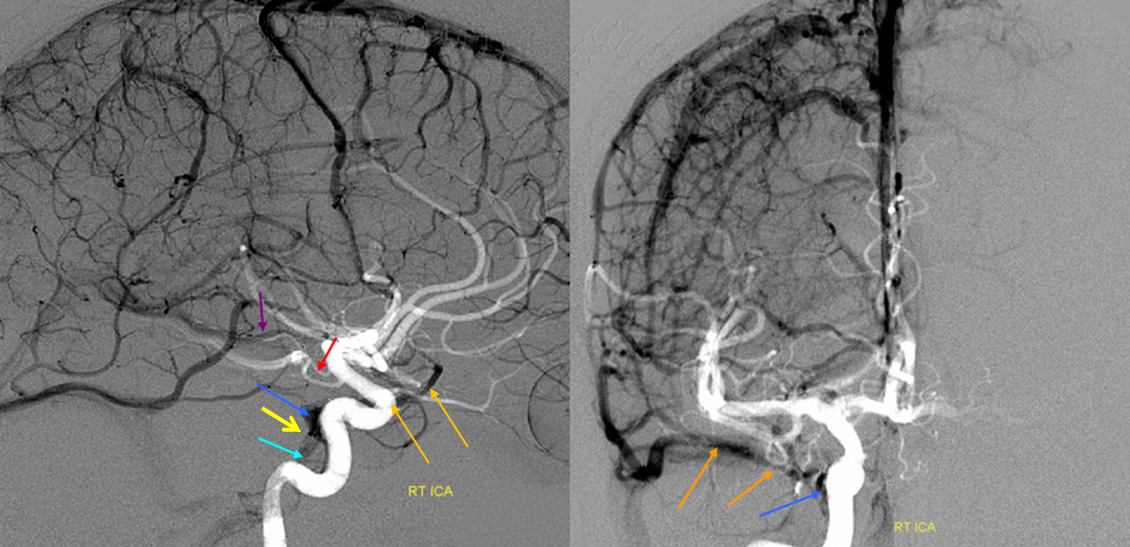
The more typical uncertainty of cavernous sinus borders, particularly at the distal aspect, has important clinical significance in terms of deciding whether a given aneurysm is purely intracavernous (and therefore extradural), or distal to the cavernous sinus (clinoid, paraophthalmic, or whatever your boss calls it, and therefore potentially intradural). Consequently, aneurysms in uncertain locations (probably distal to the cavernous segment, and probably not yet intradural) are sometimes called “transitional”, underscoring the uncertainty.
The cavernous segment can be subdivided into various segments, as seen below. There exists simply endless variability in cavernous sinus and ICA cavernous segment geometry, with all manner of straight and curved segments and subsegments — to the great delight of computational fluid dynamics enthusiasts and classification junkies (like us). There are also immediately practical endovascular implications in terms of navigability, catheter support, and implant (stent) behaviour around the various curves.
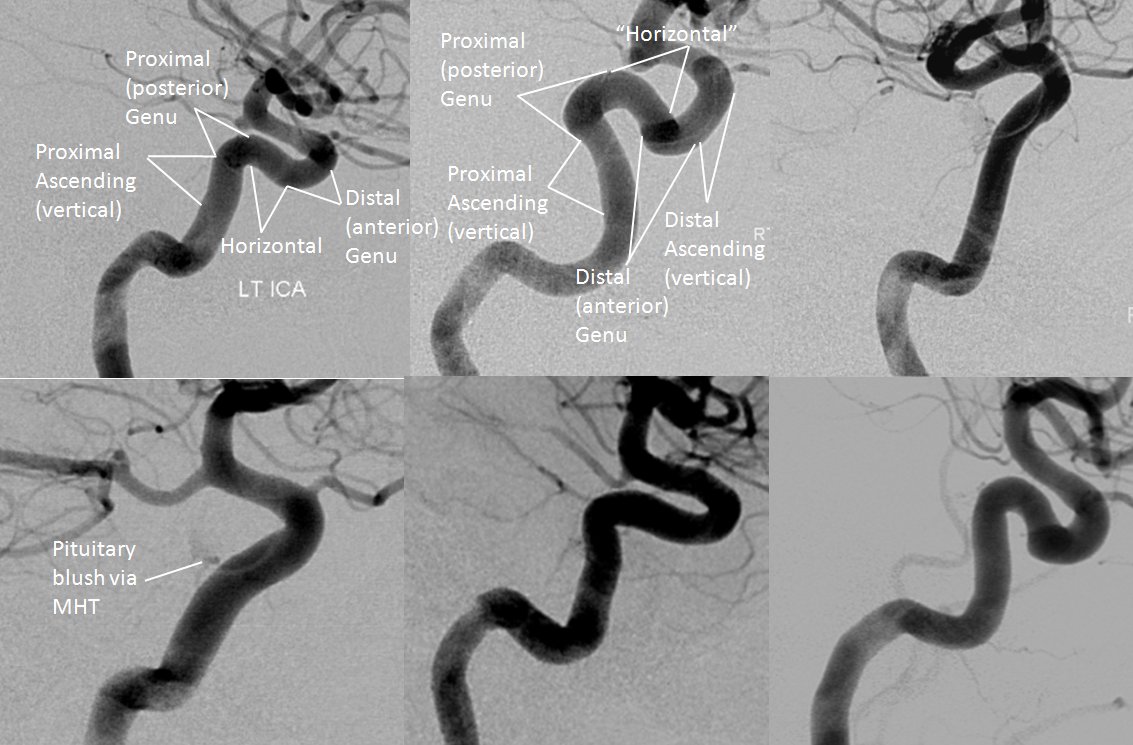
The important Meningohypophyseal Trunk arises from the genu (bend) of this segment. Its prominence is variable, of course, as its territory is in balance with those of the ILT, clival branches of the Ascending Pharyngeal Artery, and with the MMA. It most typically will be seen as supplying the hypophysis, with a characteristic early blush and early venous phase (not to be mistaken for a dural fistula). The famed artery of Bernasconi-Cassinari comes from there also. In the image below, the lateral tentorial arcade arising from the proximal genu supplies a small sigmoid sinus fistula (orange).
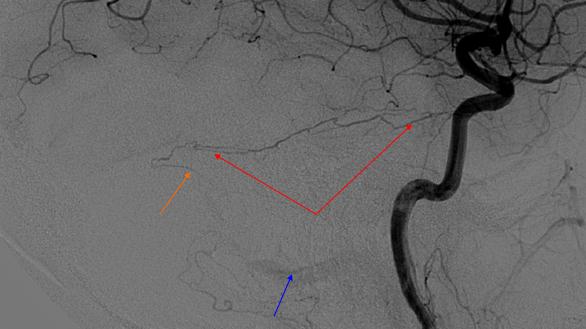
The second important branch of the cavernous segment is the Inferolateral Trunk (ILT), which supplies the floor of the middle cranial fossa, cranial nerves of the cavernous sinus, and is in balance with the Middle and Accessory Meningeal Arteries. Therefore, it is a potential conduit to the ophthalmic artery, expressed in its full prominence as the dorsal ophthalmic (red arrow).
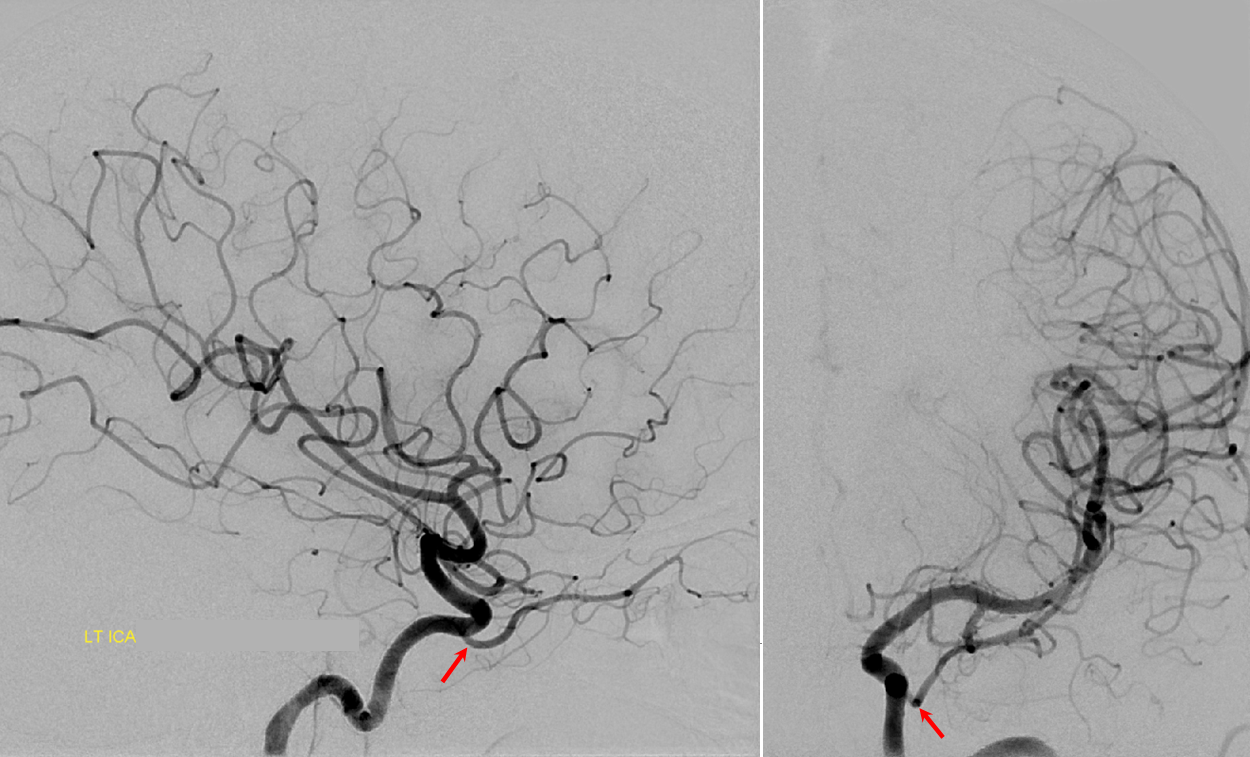
On occasion, one can appreciate slight enlargement in ICA caliber within the cavernous segment. Whether this is physiologic, within a particular cavernous compartment (akin to constriction of the vertebral or radiculomedullary artery when piercing the dura), or a marker for future Cavernous Segment aneurysm development is unclear. The distal constriction (distal yellow arrow) is as reliable an angiographic marker of the proximal dural ring as any other. This is a lateral left ICA injection in a young epileptic patient status post craniotomy (blue arrow) and subdural strip placement (purple arrow) for invasive EEG monitoring (study done as part of Wada evaluation). Notice enlarged ICA caliber of the cavernous and transitional segments, between two yellow arrows. The distal arrow points to vessel constriction which probably marks the location of the dural ring, and its corresponding intradural transition. The ophthalmic artery ostium may be extradural. Notice hypertrophied anterior meningeal artery, post craniotomy-related MMA sacrifice.
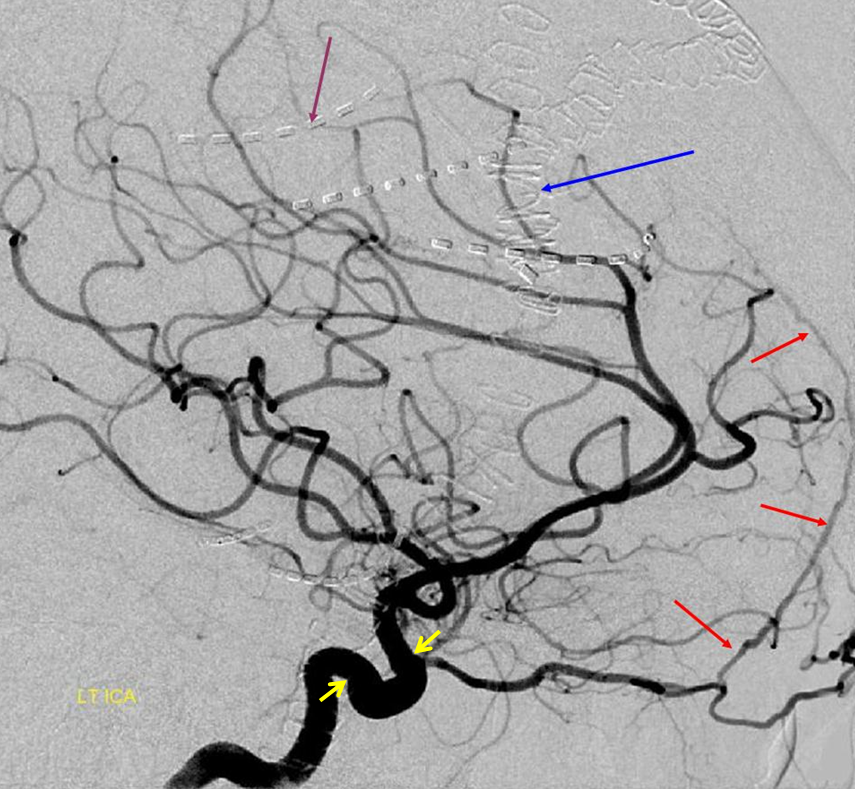
On the other hand, it is also important to recognize the physiologic variability in vessel size based on local and systemic factors — spasm and vasodilatation. When catheter-related, these are usually straightforward, but it is not always so. As an example, see pre- and post- AVM resection angiograms of this patient, where the cavernous segment is perfectly delineated as a region or relative vascular constriction (left image, yellow arrow), whereas the subsequent study the same area (red arrow) actually marks a subtle change towards relative dilatation. This is not related to any catheter manipulation. The MHT is labeled with blue, and ILT with purple arrows.
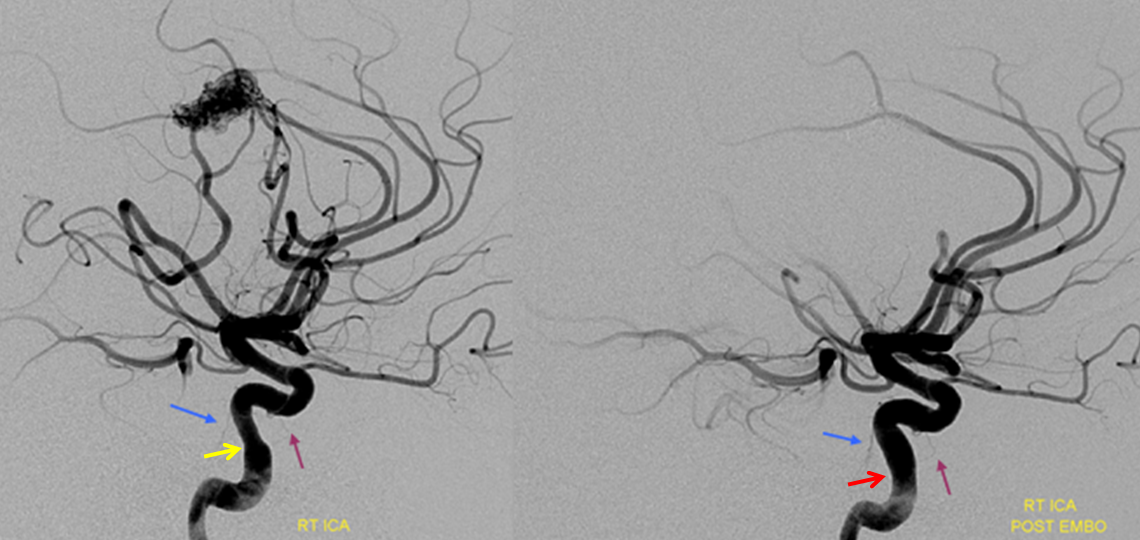
ANEURYSMS
What is certain is that nontraumatic cavernous aneurysms are usually fusiform, and have a strong female predominance. The former observation seems to run somewhat at odds with the theory of preferred aneurysm origin at vessel ostia, as championed by the superb works of Rhoton. For example, the superior hypophyseal aneurysms are felt to arise at the ostia of superior hypophyseal arteries, not to mention the ophthalmic, PCOM, choroidal, etc. Curiously,saccular aneurysms rarely form in association with the more consistently visualized MHT and ILT, which are first in line to receive the brunt of supra-petrous ICA inflow. The hypertension theory is also suspect, as there are many patients with such aneurysms having no hypertension, and incidence in men is rare. It seems much more likely that the underlying cause has a primary genetic basis.
The majority of cavernous aneurysms preferentially expand laterally, into the cavernous sinus. It is a fact of singular consistency that the proximal vertical subsegment (from the PLL to the posterior genu, yellow arrows) is very rarely involved, even when the remaining cavernous ICA is transformed into a monstrous deformity (see image below). The explanation for this observation seems to be missing in the literature (please correct me if you come across any!)
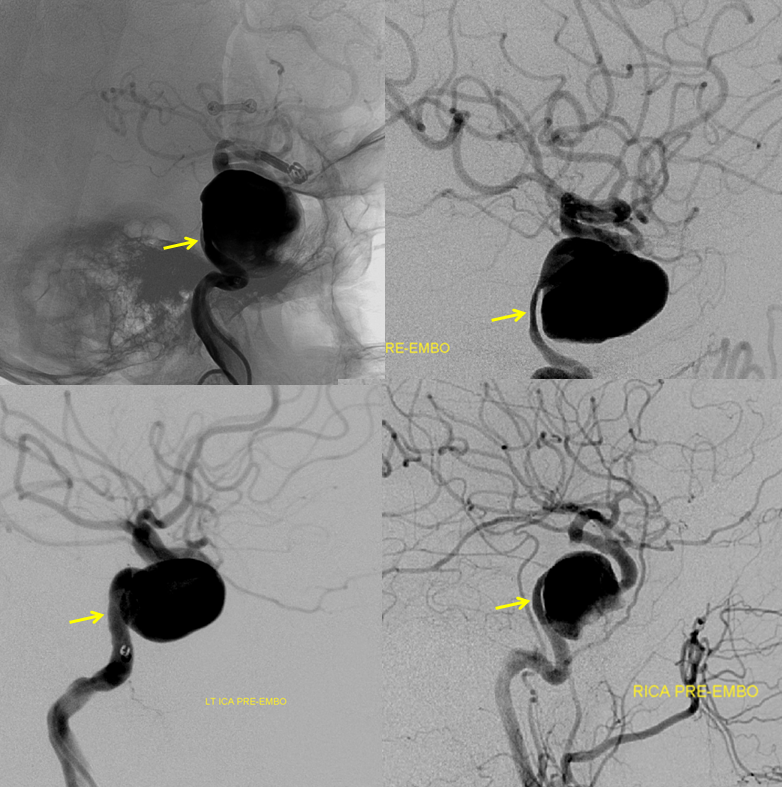
Even when involvement of the vertical segment is suggested by some images, angiograhic techniques such as earlier phase or 3D-DSA imaging can help clarify the situation (below). Note actual transition into the aneurysmal segment (red arrows). A small “waist” marks the petro-cavernous transition in the upper case.
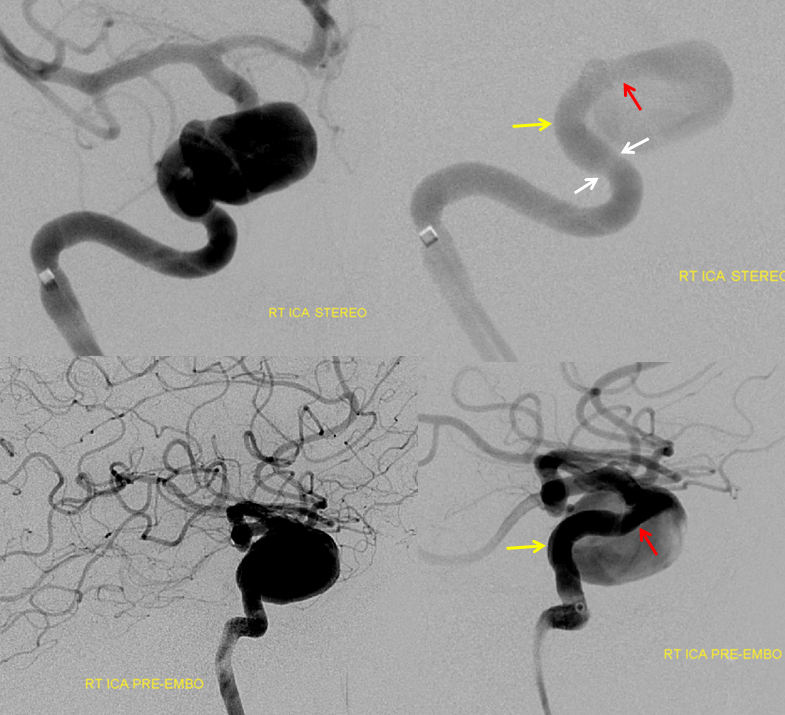
Typical laterally-expanding cavernous segment aneurysm (shown below). The medial border of the cavernous ICA is reinforced by bone, and aneurysms only very rarely expand there. In fact, seeing one should prompt doubt as to whether it is, in fact, cavernous in origin (rather than transitional), and deserves a CT scan to evaluate bone integrity.
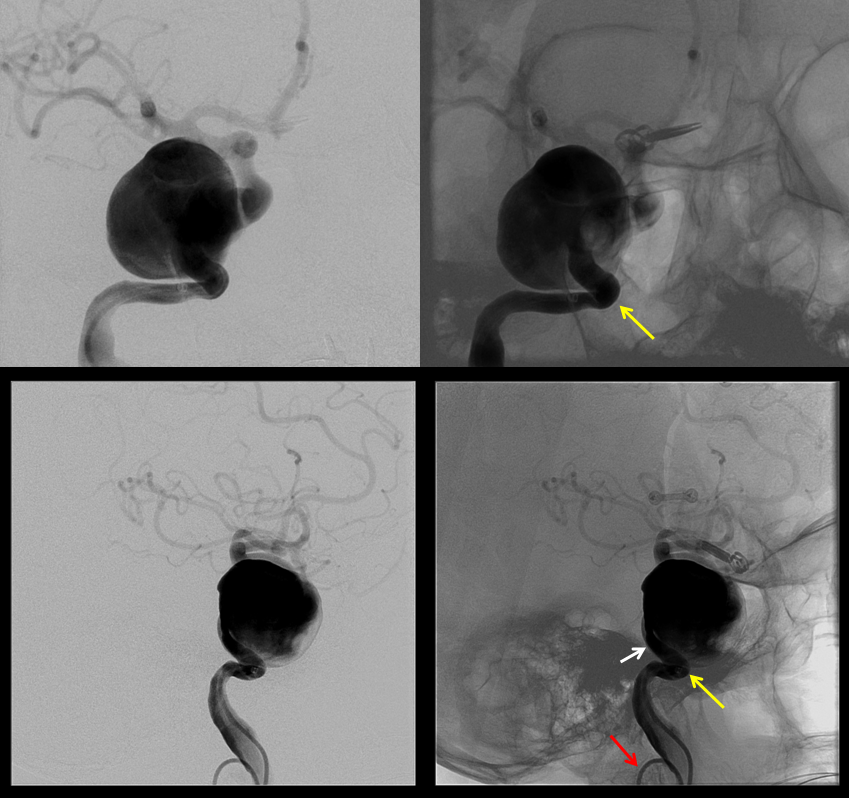
Clinical Presentation
Typical presentation is with CN III, IV, VI palsy, or CC fistula. Volumes of literature have been written on clinical presentation and management of these aneurysms. Aneurysms of the anterior genu, when large enough, may present with CN II findings, most likely due to mass effect — by which time they are likely to be partially intradural. The historically benign course (when asymptomatic) of cavernous aneurysms has recently come under scrutiny. The bulk of these aneurysms are now being treated by endoluminal techniques.
Frontal and lateral projection DSA and native views of right ICA injection of a distal support catheter, visualizing a 3.2 cm, laterally-projecting cavernous segment aneurysm in a patient presenting with CN III palsy (see below). Notice mass-effect with posterior displacement of the proximal cavernous and laceral segments (white arrow), exacerbating angulation at the petrous-laceral junction (yellow arrow). A cervical internal carotid artery loop is also present (red arrow) — all of these factors serve to complicate ICA catheterization beyond the aneurysm and decrease stability of embolization setup. The patient is status post remote craniotomy and clipping of ruptured ACOM aneurysm.

3D-DSA view (left), from medial to lateral, of the same aneurysm, underscoring its typical lateral growth pattern. Various measurements have been made as part of Pipeline embolization planning; center DSA frontal oblique projection image with additional careful measurements; image on right demonstrates a Pipeline construct of multiple overlapping devices.
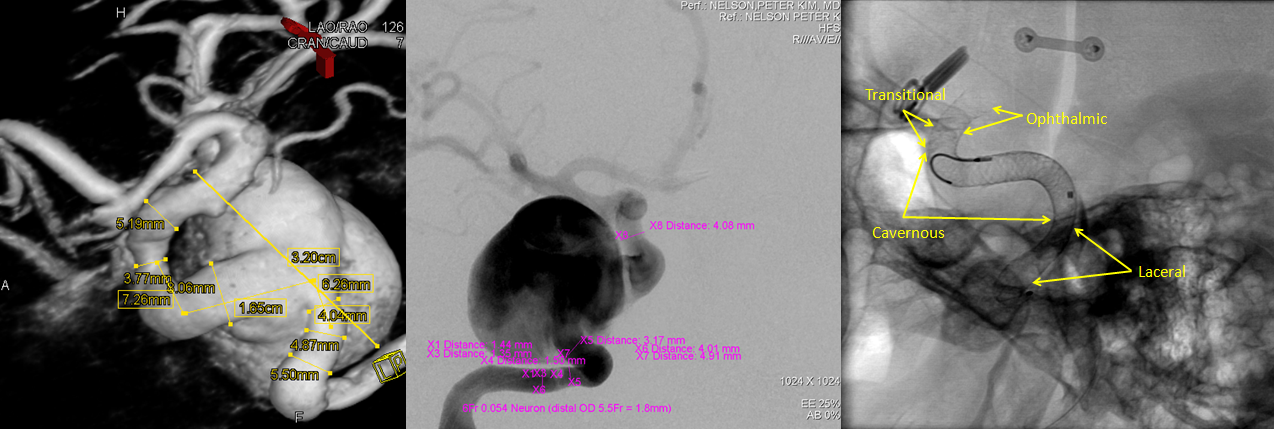
Cavernous aneurysms are not infrequently associated with cerebrovascular anomalies, underscoring a developmental susceptibility in this patient population. This man presented with complete ophthalmoplegia, due to a giant, partially thrombosed (green arrows) cavernous segment aneurysm. Notice unusual origin of the anterior cerebral artery (yellow) from the ophthalmic segment of the ICA (ophthalmic artery in purple), with a small transitional aneurysm at the trifurcation (pink). The supraclinoid segment (red) is normal. The ACA pursues an infraoptic course (below the optic nerve), as does the rarely seen ventral ophthalmic artery — in fact this variant is a perfect demonstration of the infraoptic “A1” segment ACA in fact representing the ventral ophthalmic artery portion extending from the ACOM complex to the ophthalmic segment . Notice tight turn at petrous-cavernous transition (curved arrow) due to aneurysmal mass effect. Right ICA injection shows redundant A1 segment (white arrow), another developmental anatomical variant. T2 MRI shows infraoptic course on the left, and supraoptic on the right. See “Ophthalmic Artery” page for discussion of the ventral ophthalmic and other important variants.
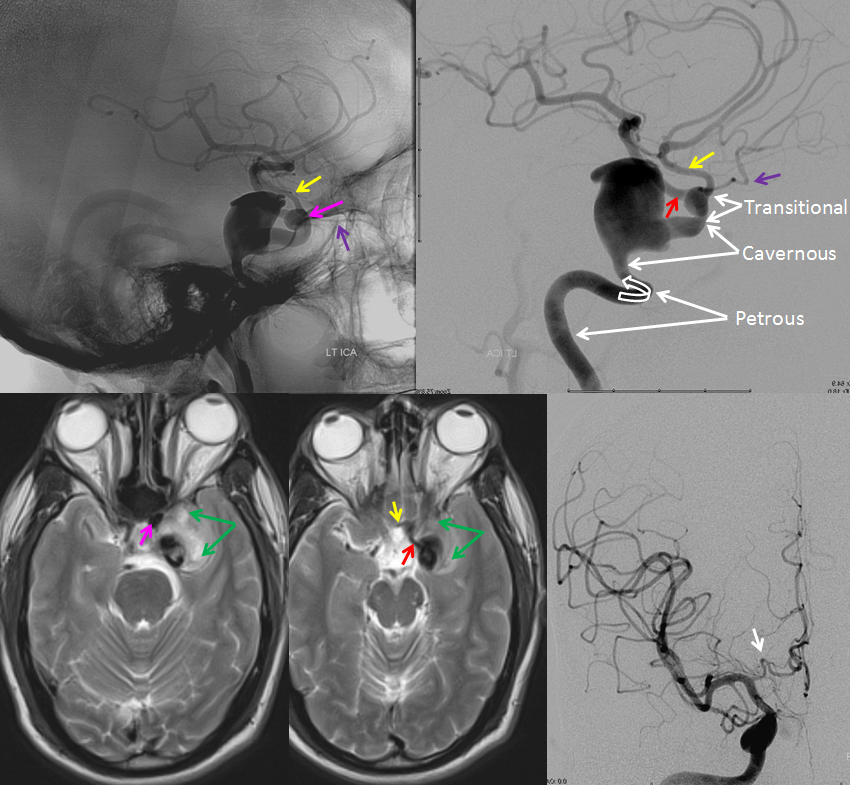
Stereoscopic view of 3D-DSA, from medial to lateral, demonstrating preferential lateral aneurysm expansion and ophthalmic segment anatomy, and the infraoptic ventral ophthalmic / A1 segment. Notice a well-developed mandibulovidian artery (white arrows).
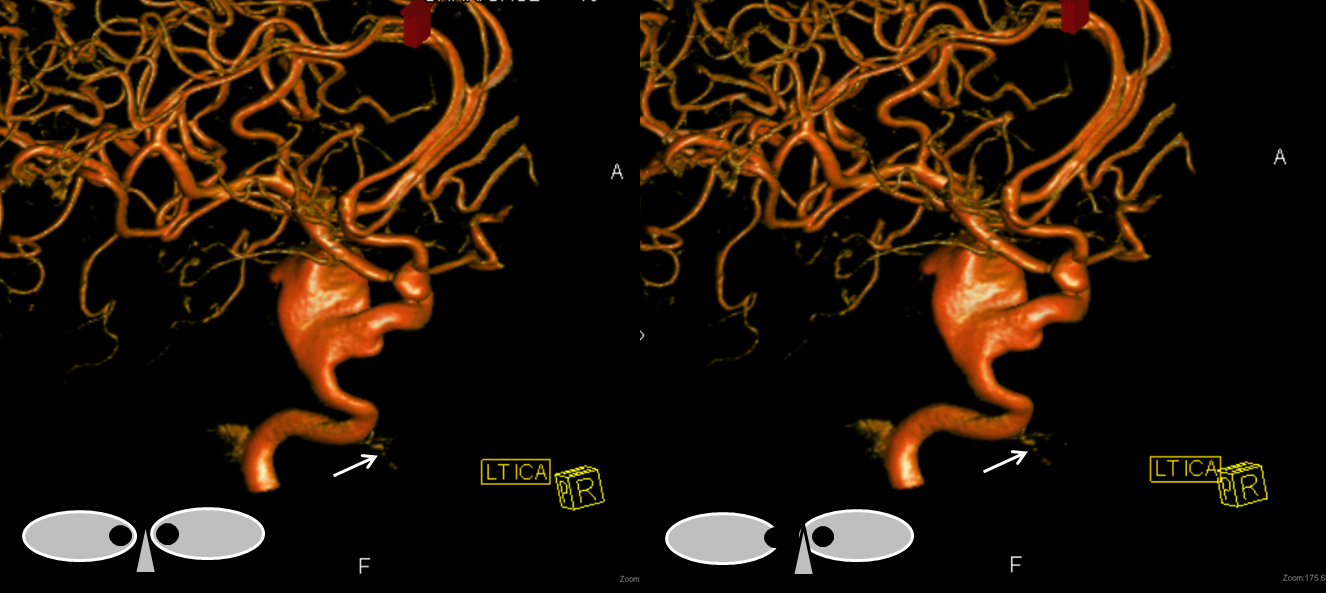
Lateral projection views immediately post Pipeline embolization (top), and 4 months later (bottom). Notice branches of the MHT (purple arrows) which remain open, and are now visible after the aneurysm has disappeared. The mandibulovidian artery is again marked with white arrow.
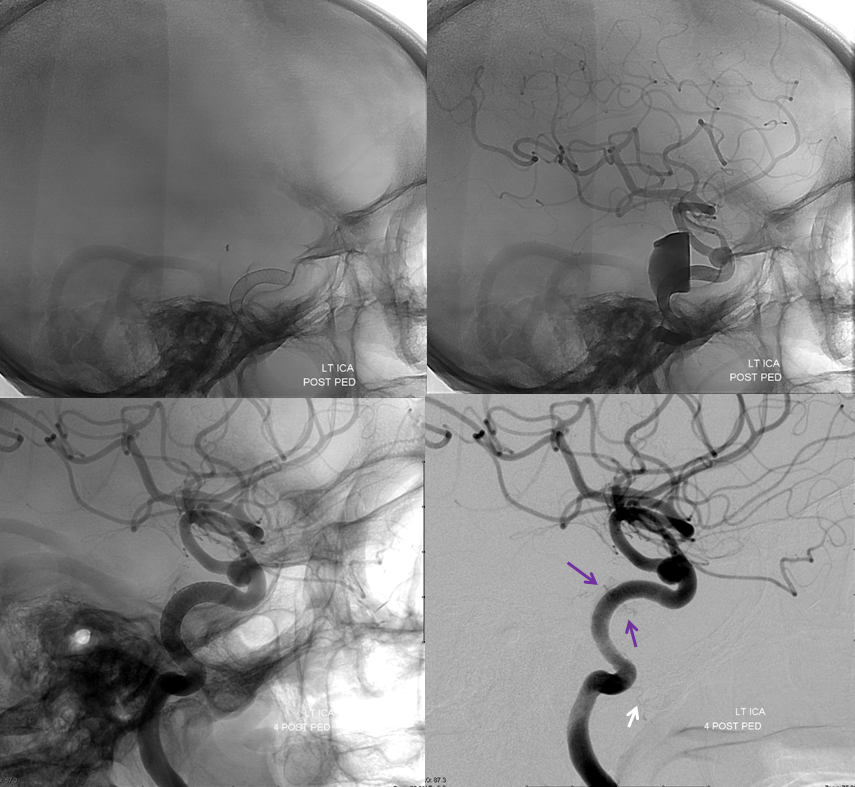
Medially-projecting cavernous aneurysms (yellow arrow), though relatively uncommon, expand toward the sphenoid sinus, and will eventually erode its coverings (white arrows marking edges of the osseous cover), exposing the patient to potentially catastrophic epistaxis. When seeing a medially-projecting cavernous aneurysm, CT is mandatory.

This man presented with intractable epistaxis, in setting of immune deficiency secondary to lymphoma. CT scan showed dehiscence of the posterolateral left sphenoid sinus, which was filled with blood and nasal packing. Angiography revealed a pseudoaneurysm of the cavernous segment (white arrow) protruding through the dehiscent sphenoid wall (upper center 3D-DSA image.
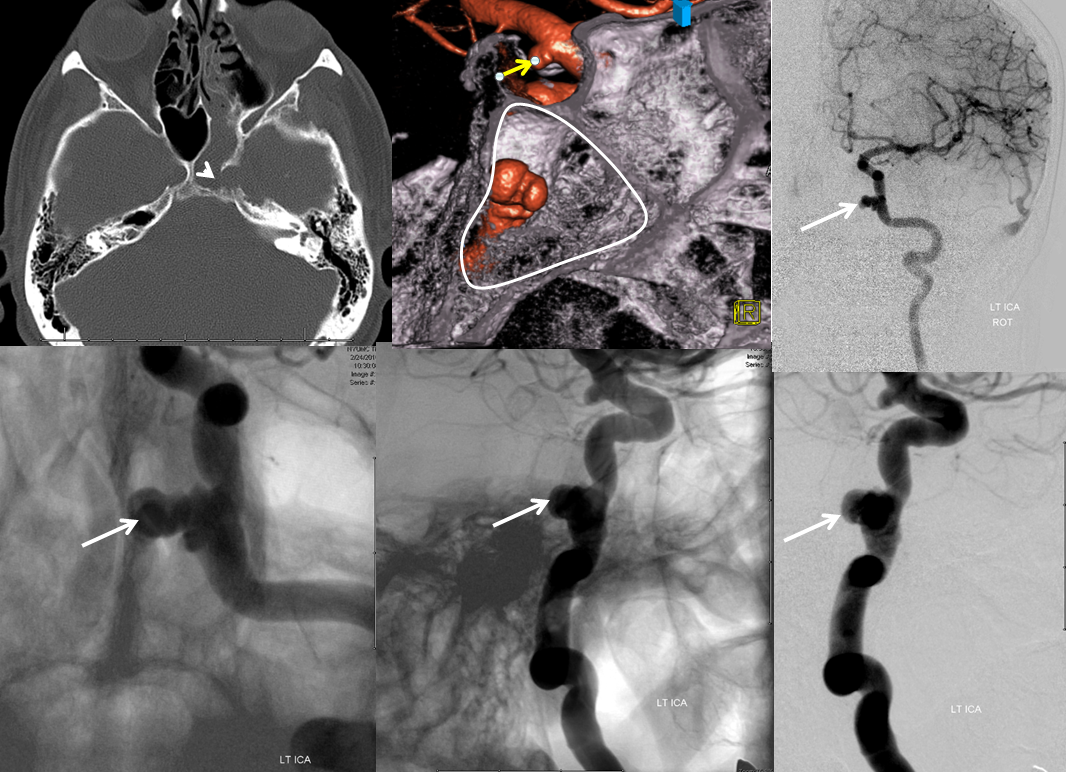
A very cool 3D-DSA stereo of the same patient. Look for prominent MHT and pituitary blush (unlabeled). The patient was treated with EC-IC bypass and carotid takedown (not shown, but did well)
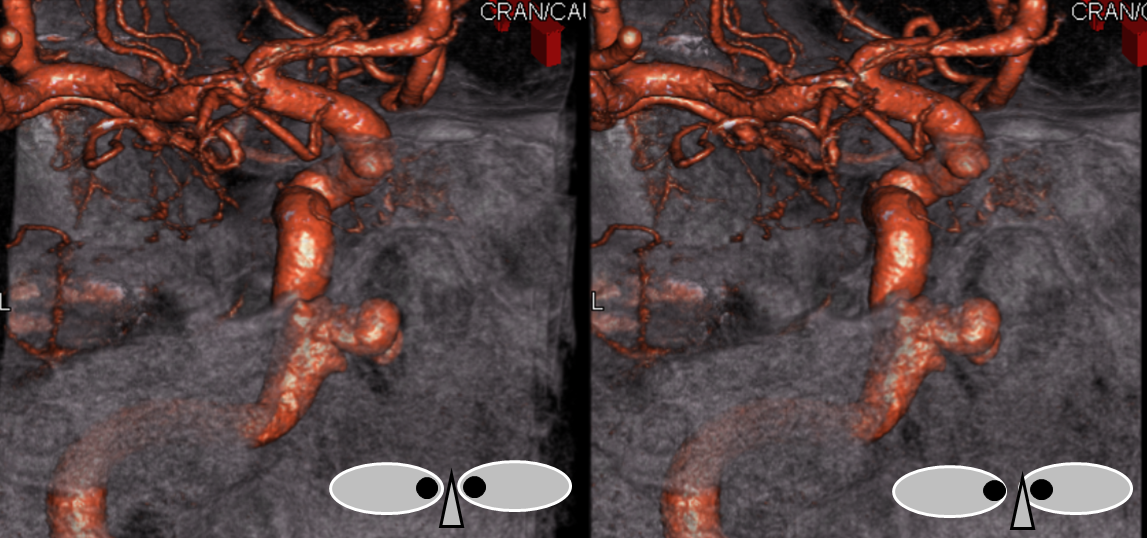
In this case, mass effect from a giant cavernous segment aneurysm led to stenosis of the proximal vertical subsegment — you can see progessive constriction as ICA emerges from relative protection of the temporal bone, and runs along the back of the cavernous aneurysm. Also important to recognize are indentations on the upper dome of the aneurysm (purple and red arrows), marking location of the distal dural ring, where the aneurysm expands through the ring into the intradural space — as most large/giant cavernous aneurysms eventually do. Lateral projection native image on bottom left shows Pipeline construct in place, following angioplasty of the lacerum segment. At 6 months, the carotid is closed; the patient remained asymptomatic due to robust circle of Willis collaterals.
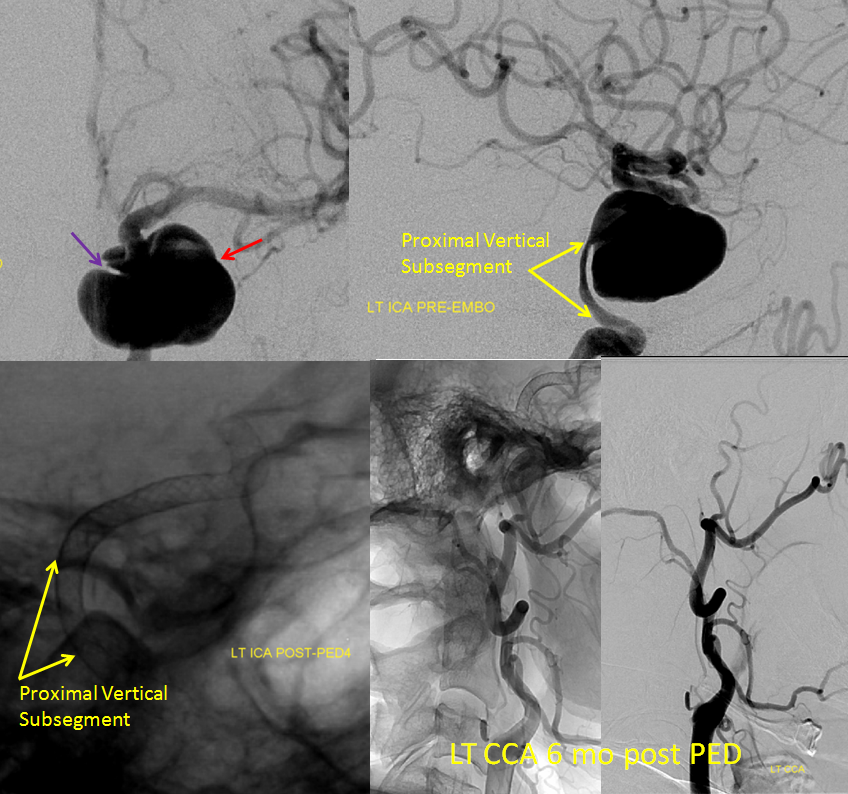
In the interest of space and time, the cavernous segment section is truncated here. Images galore of countless cavernous aneurysms can be found on the dedicated Cavernous ICA aneurysm page.
Transitional (Clinoid) Segment

The cavernous segment ends when the ICA passes through an opening in the anterior cavernous sinus wall called the “proximal dural ring” (PDR), which extends from the inferior surface of the anterior clinoid process to the medial carotid wall. This happens somewhere along the distal vertical /ascending cavernous subsegment. The exact location is impossible to determine angiographically. Past the PDR, the ICA does not immediately become intradural / subarachnoid. A short but very important segment, where the ICA is sandwiched between the PDR and the Distal Dural Ring, (which marks the intradural transition), is neither intracavernous nor intradural. The Distal dural ring is generally tougher than the proximal one, and extends from the upper surface of the anterior clinoid to the medial carotid wall. The importance of both rings, and the space inbetween them, was duly recognised by the pioneering vascular neurosurgeons, and many excellent works exist for the dilligent reader — see Rhoton, Day, Bouthillier, and others. This segment goes by many names, reflecting its prominence. The one in most widespread use — clinoid segment — was coined by Bouthillier. It was specifically defined as that between the two dural rings (an exact surgical definition is possible, whereas angiographic one is not). It is wedge-shaped when seen from anterior (look at the Bouthillier classification figure above). Reflected in the name was an implication that access to clinoid ICA and its aneurysms necessitated an anterior clinoidectomy, which substantially increased both complexity and risk profile of the operation.
From an angiographic perspective, the problem is that one simply cannot visualize either ring. Therefore, it is not clear where the cavernous segment ends (proximal ring), nor where ICA becomes intradural (distal ring). Some noninvasive cross-sectional methods (MRI and CTA) were published to that effect. The problem with these kinds of studies, as I see it, is threefold. First, none of currently available imaging methods can visualize the actual rings, and so rely on landmark identification to guesstimate their location. This approach suffers from limitations of extensive anatomical variation in landmark position, found in this region as much as elsewhere. Second, regional anatomy, and dural rings in particular, are modified by disease (aneurysms), which remodel, distort and destroy adjacent tissue (dehiscence), such that, short of surgical dissection and microscope observation, the integrity of dural ring can never be fully determined in setting of adjacent pathology. Third, aneurysms of this region are frequently irregular and dysplastic, extending accross adjacent segments.
The image below illustrates these concepts — guesstimating various boundaries on angio. The ophthalmic ostium is in red. The anterior clinoid position, which cannot be seen well on the AP view, is outlined in white. So is the sphenoid sinus which can be seen sometimes. The proximal ring (yellow line) extends from clinoid undersurface to medial ICA wall. The distal ring (purple line) comes off the clinoid roof. The Clinoid segment is defined as the space between the two rings. The carotid cave (pink triangle) is a small potential space under the distal dural ring.
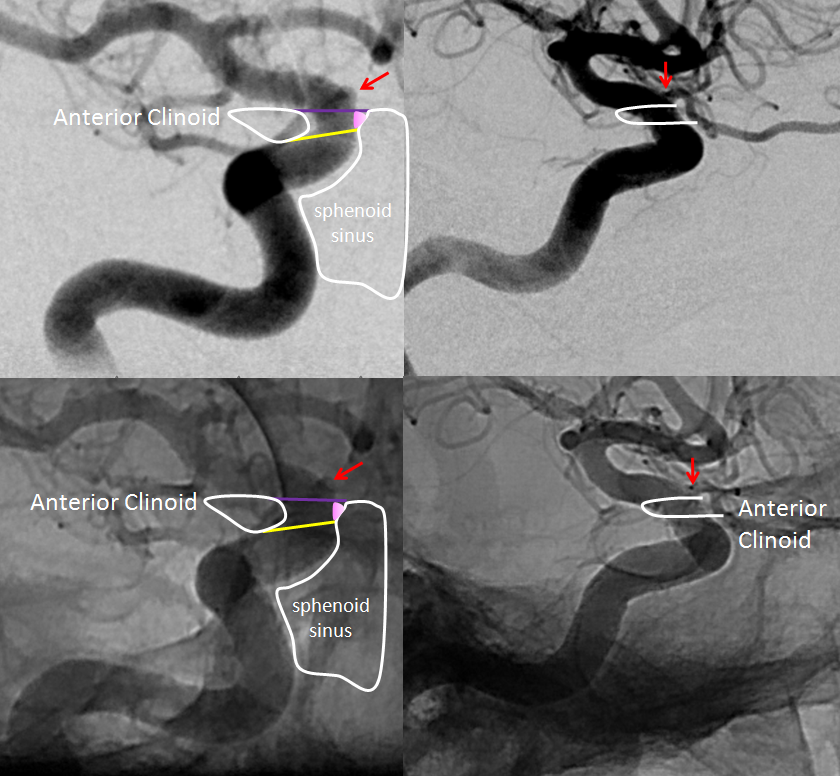
Absolutely magnificent dissections of this area (among others) can be found in the spectacular works of Rhoton, which are (or should be) familiar to any neurosurgical pracititioner or trainee. The series is published in Neurosurgery 51 [Suppl 1]:121–158, 2002; of particular interest to this discussion is Chapter 3, which deals with Aneurysms, and Chapter 9 — The Cavernous Sinus, The Cavernous Venous Plexus, and the Carotid Collar. With Dr. Rhoton’s kind permission, the following figures are re-e-produced:
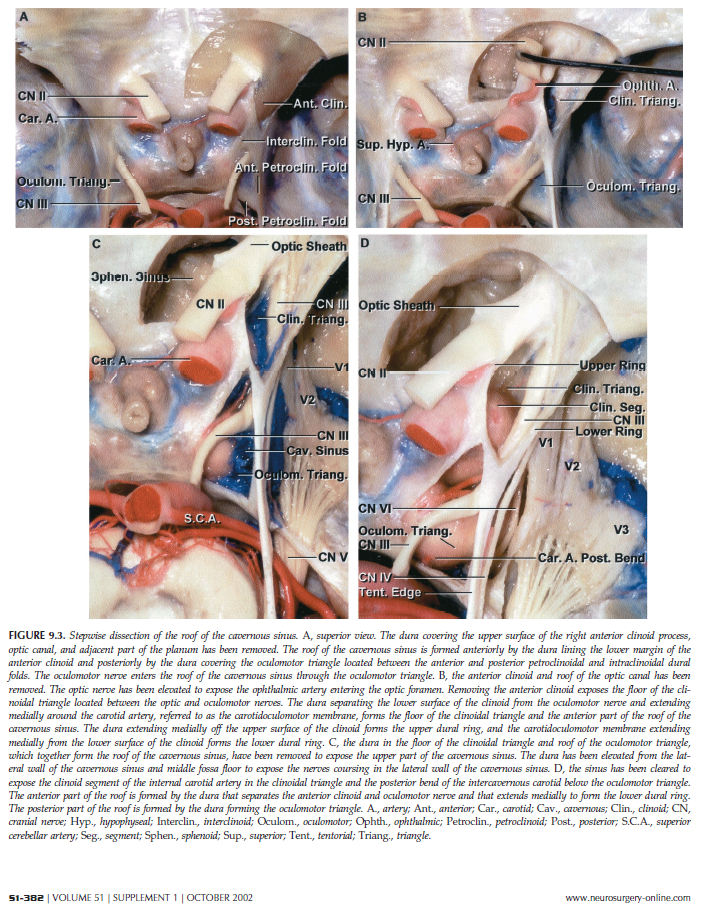
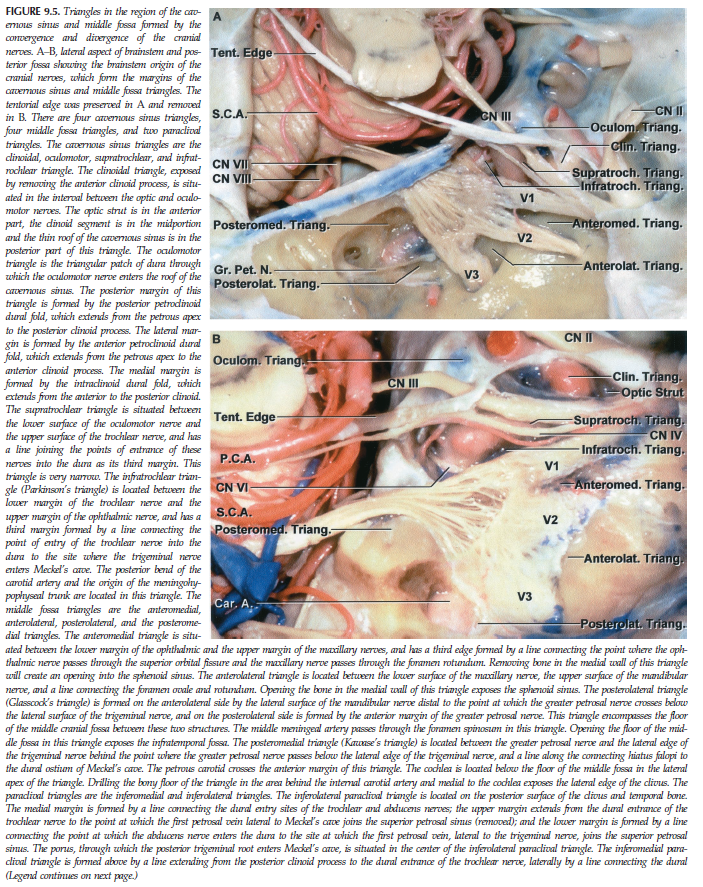
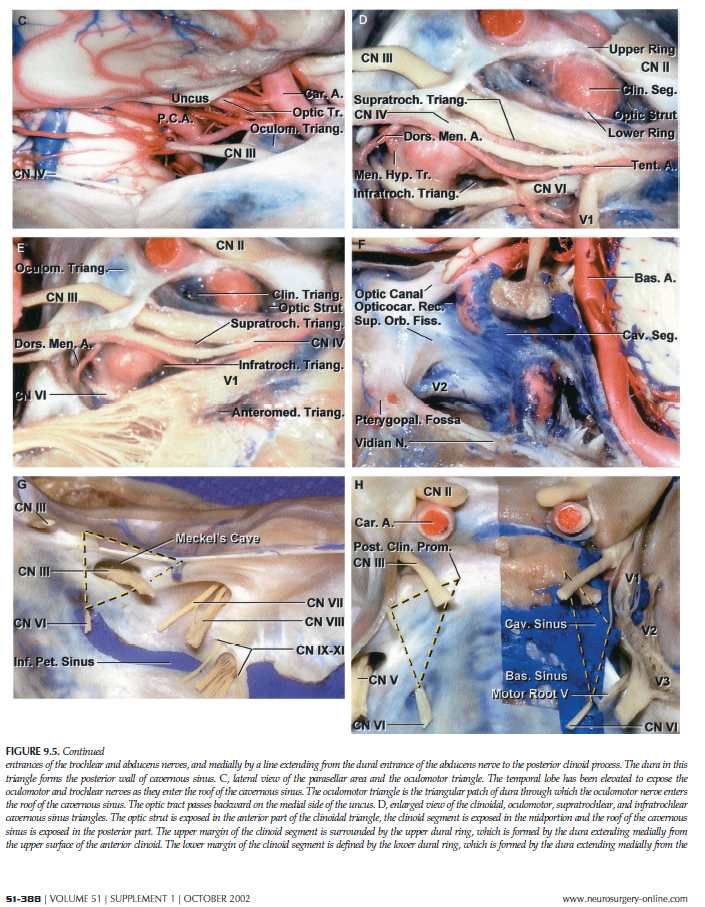
Another superb source of expert information, freely available online, is the Barrow Quarterly, which ran through 2008, and was overseen by the great M. Spetzler. A number of articles in the Quarterly have addressed intracranial ICA anatomy of the years. The specifically usefeul article on the matter, in Barrow Quarterly 18(2), 2002, titled Microsurgical Anatomy of the Anterior Cerebral Circulation: Part 1. The Infraclinoid Internal Carotid Artery, found at this link: http://www.thebarrow.org/Education_And_Resources/Barrow_Quarterly/205270
The full list of Publications is available at http://www.thebarrow.org/Education_And_Resources/Barrow_Quarterly/index.htm
In summary of this relatively long (for neuroangio.org) but necessary discussion:
1. There is intrinsic angiographic uncertanty about location of the proximal and distal dural rings, with which one must become comfortable. It is often simply impossible to conclude with certainly whether aneurysms at the upper vertical genu are cavernous (extradural), intradural (ophthamic), or inbetween (clinoid, or transitional).
2. In view of this, the definition of “transitional segment” is conceptual rather than anatomic — it is that segment where the location of an aneurysm in regard to the dural rings is uncertain. Simply put, if you can’t tell — its transitional.
3. Transitional aneurysms are various — saccular, fusiform, small, large, etc. Sometimes there is less uncertainly about the dome of the aneurysm than its origin off the ICA — large aneurysms often elevate and erode the distal dural ring, such that the superior part of the aneurysm very likely becomes intradural.
Aneurysms
Aneurysms of the transitional segment are heterogeneous in all respects. Those projecting laterally may, in reality, be distal intracavernous, truly clinoid (between the rings), or partially/fully intradural. This large, laterally-projecting aneurysm has problably eroded the distal dural ring, and is therefore partially intradural — a horizontal band at the superior aspect of the dome (red arrow) most likely represents dural ring indentation, which can also be appreciated at the same level upon the medial aspect of the carotid artery (purple arrow). Subtle angiograhic clues like these can be helpful in the transitional area. Notice also, on lateral DSA projection, a small ICA indentation at the genu of the cavernous sinus (marked “Cavernous Sinus Boundary). Subtle clues like these can help guesstimate locations of angiographically-invisible structures.
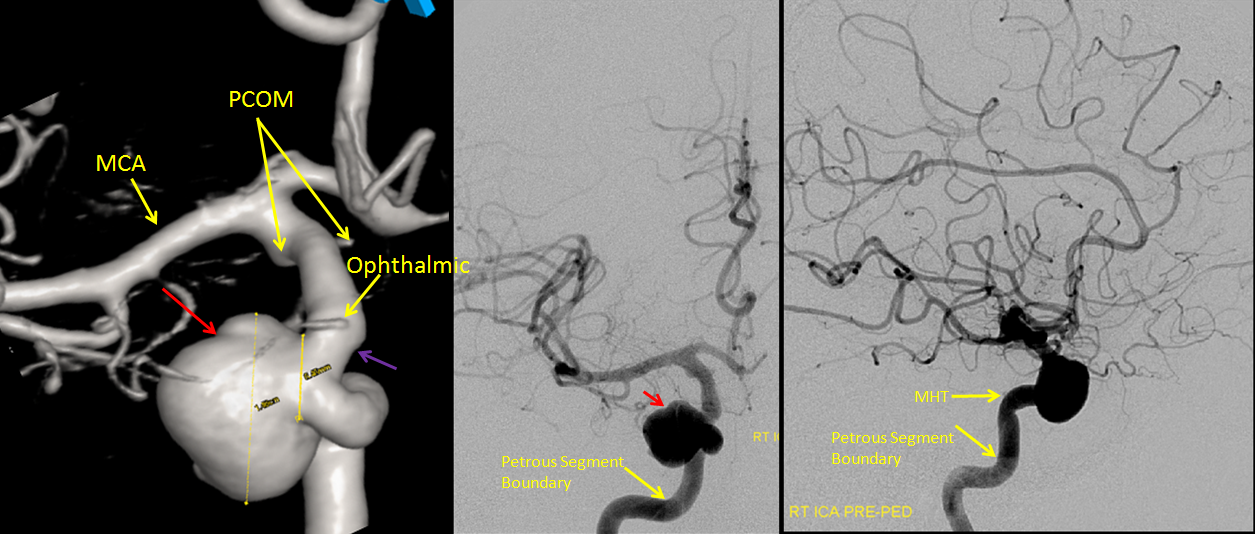
A large transitional segment, anterolaterally projecting aneurysm, is pressed against the anteromedial aspect of the middle cranial fossa, with a kind of bumpy, “paper-mache” surface (purple arrows) where it contacts the temporal bone. The entire carotid artery segment is dysplastic, with what appears as a separate “ophthalmic” segment aneurysm (red arrows) . In reality, the separation between the two aneurysms (yellow arrow) is a space for the anterior clinoid process — had the clinoid not existed, the whole thing would be one inseparable dysplastic mess.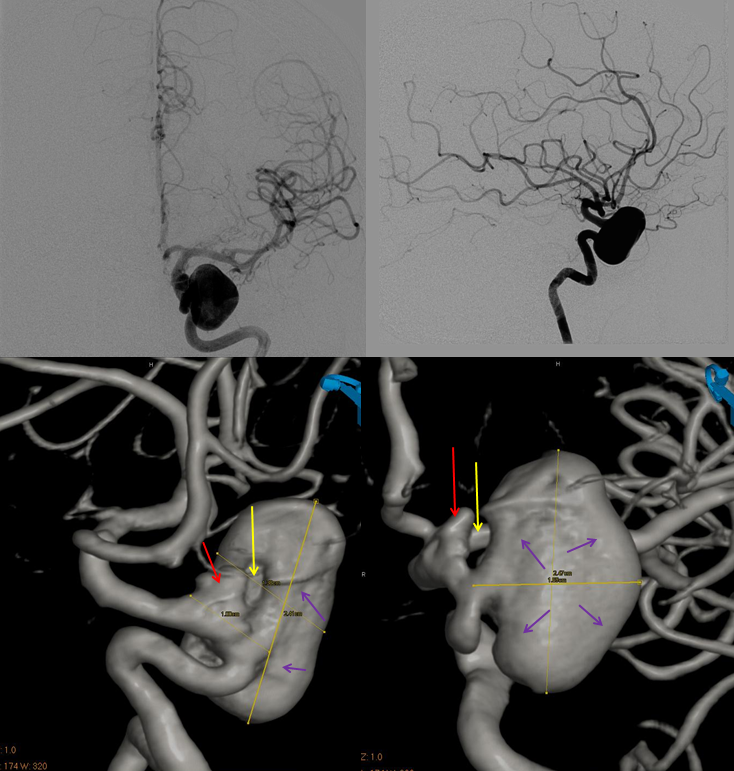
Medially-projecting transitional segment aneurysms are a special category, since they frequently fall under the distinct rubric of “carotid cave” aneurysms. These unique lesions are located within a potential space created by redundant folds of the dura on the medial aspect of the ICA. They are below the distal dural ring, and yet INTRADURAL, and thus potentially more dangeous. How to spot one — an aneurysm projecting medially from the ICA slightly below the “usual” origin of the ophthalmic artery is potentially a cave aneurysm. Can’t tell for sure — it might be cavernous, or transitional with an intact distal ring. Only a surgeon can tell if it was a “cave.” The one below is a good candidate — particularly since it points postero-superiorely, as might be expected from a cave type which extended above the distal ring.
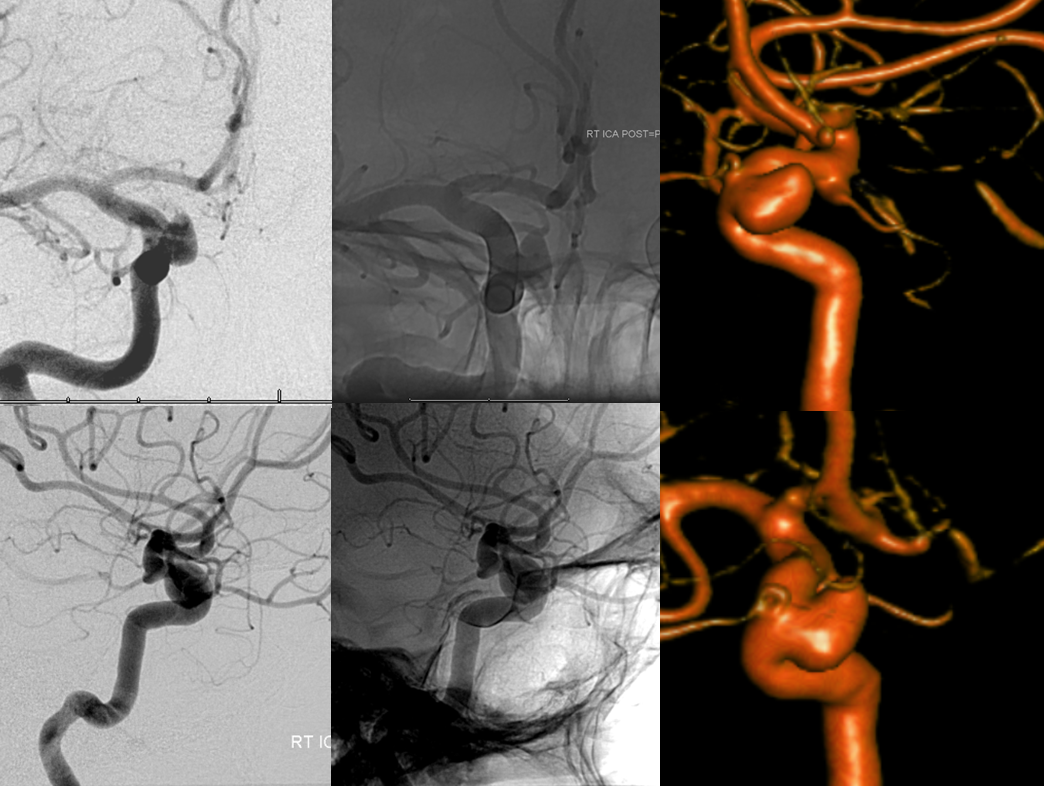
Another example of likely cave aneuyrsm below. We are watching this one.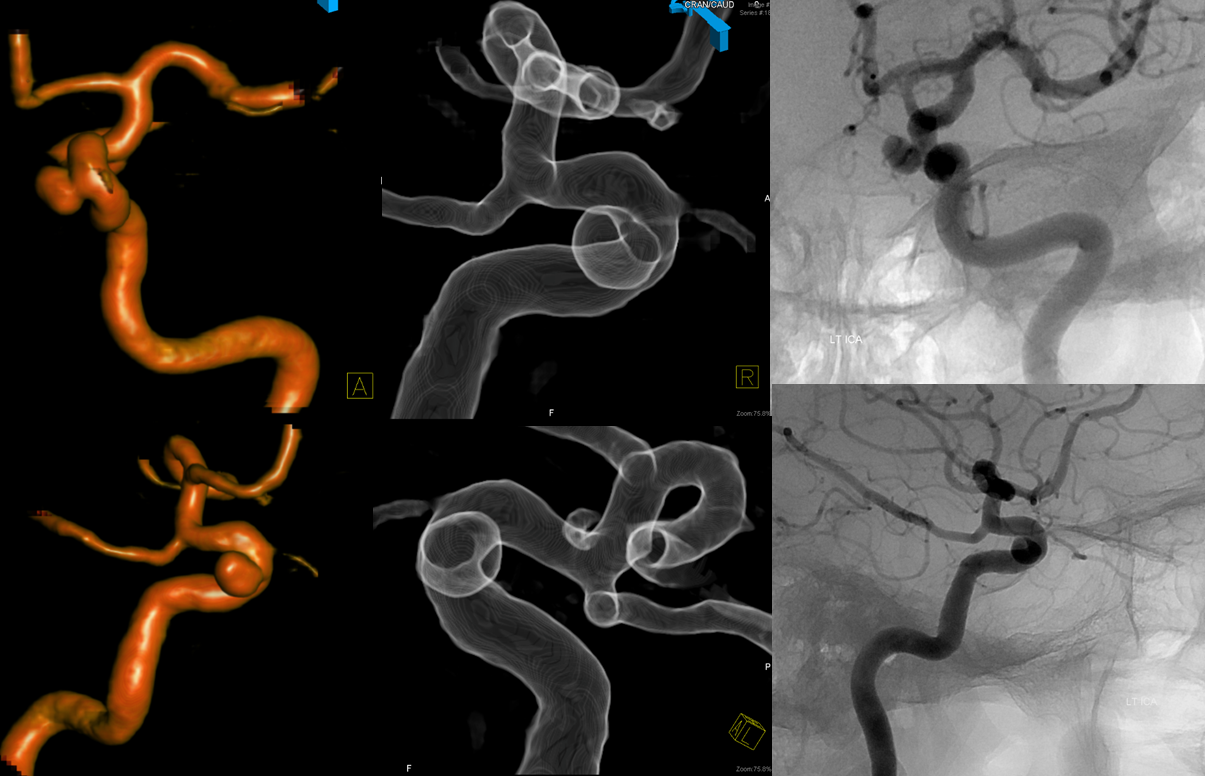
Without doubt, 3D-DSA has issues — missing branches, pulsation averaging, motion-related data loss, size uncertainty. Overdependence, at the expence of studying the much higher resolution DSA images, is another big one. But how much easier is it to find and study necks and, particularly, dome morphologies, — have to give it to 3D-DSA big time. The 3D-DSA image is particularly instructive for those who look to underlying ICA dysplasia as a necessary pre-condition for aneurysm growth. One can readily appreciate how most necks are imperfect, with ledges, nooks, and folds that will not readily accomodate a coil loop. Look, for example, at this seemingly regular (from DSA images) transitional aneurysm (red arrow) — notice how the neck portion extending from the back wall is elongated (blue arrow), and is unlikely to be filled with coil. There is no way to appreciate this morphology from DSA (yellow arrow). Also look at the small horizontal impression on the aneurysm dome (white arrow) — a guess, but this is probably an impression made by the proximal ring — which means the aneurysm is partially intracavernous, and partially clinoid. Just a guess, but worth thinking about.
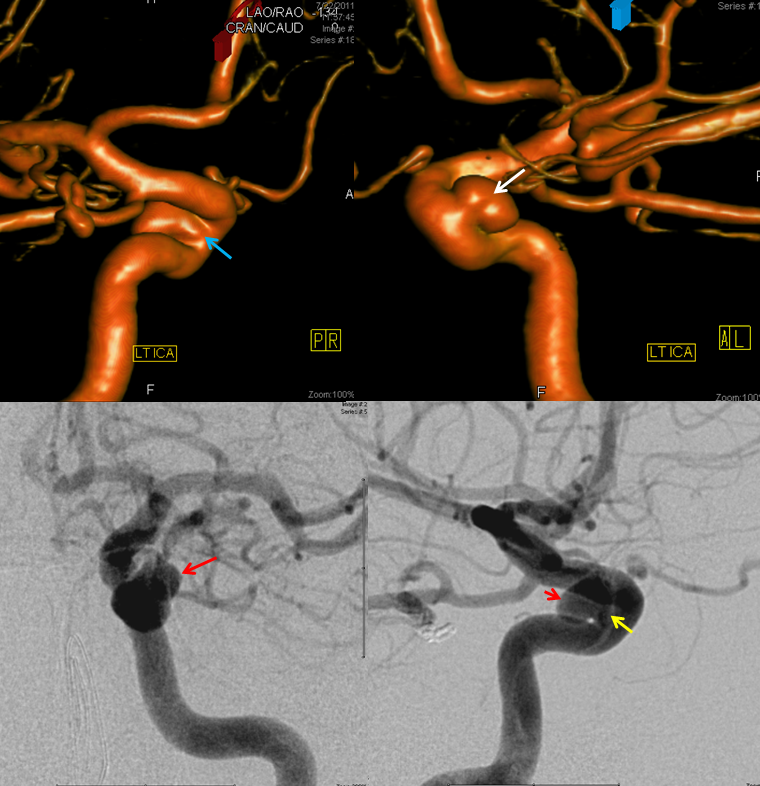
As promised, along the theme of segmental dysplasia, with an example of three “separate” aneurysms, the largest (yellow arrows) being a laterally-projecting transitional type, and two hypophyseal ones (pink and purple) as well.
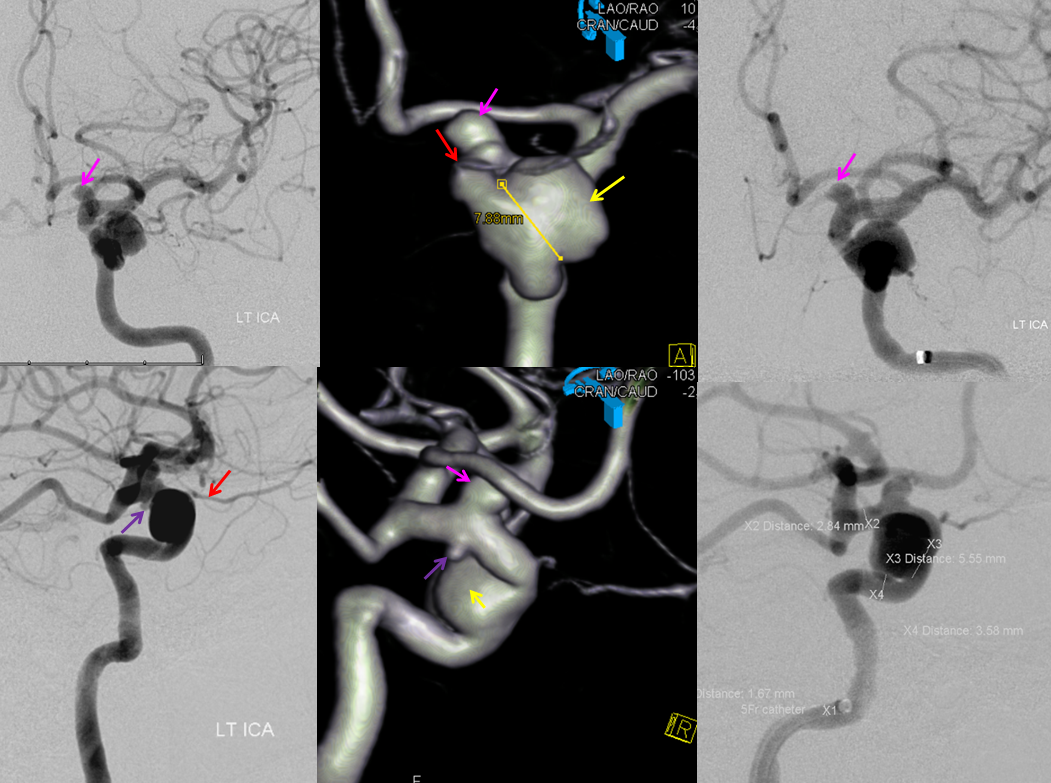
Ophthalmic Segment Tired yet? We are just getting started here… stay on target
Bouthillier defined the “ophthalmic segment” as extending from the ophthalmic artery ostium to the PCOM. The conundrum with this ICA segment, immediately distal to the dural ring, (aside from the fact that we can’t tell for sure the location of distal dural ring) is that it does not always contain the ophthalmic artery. In its “classic” location, the ophthalmic ostium is located just distal (1mm) to the dural ring — and therefore intradural. However, the vessel may arise either somewhat more distal to the ring (as far up as the ACOM — ventral ophthalmic variant), or somewhat proximal — in which case it may be extradural — within “transitional” or cavernous segments, as seen below.
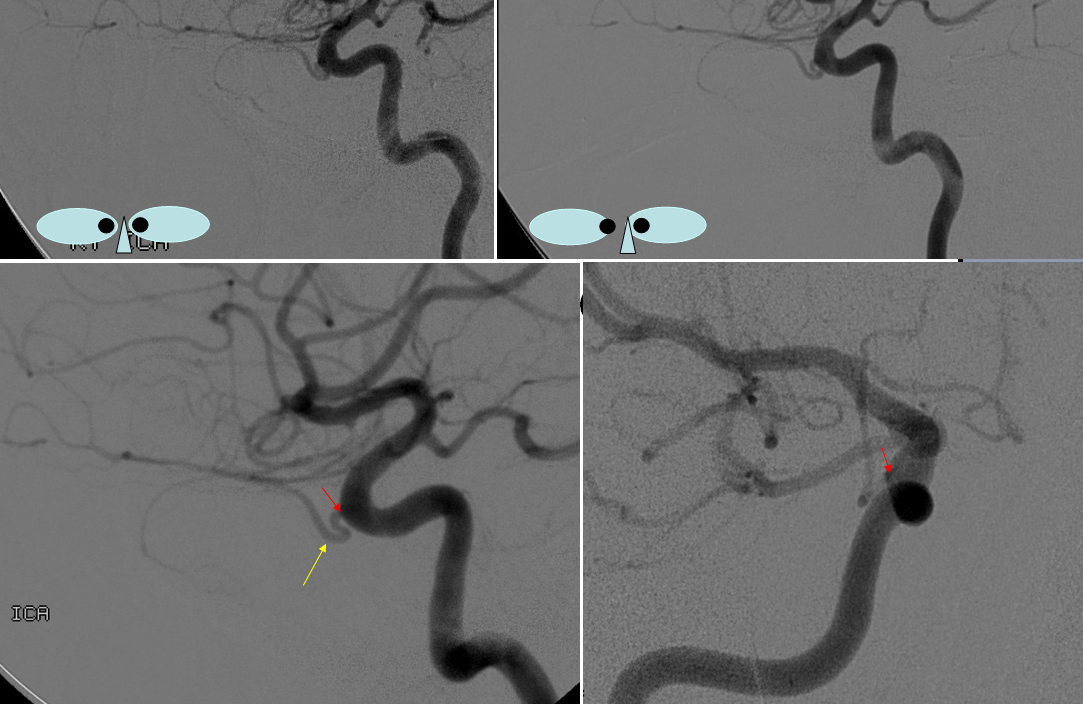
Stereoscopic lateral projection views (top row) and frontal + lateral DSA of RT ICA injection, demonstrating ophthalmic artery origin from anterior genu of the ICA, proximal to its usual location — the ostium may be located within the cavernous or transitional segments, but is definitely too distal for the ILT. Usually, this kind of ophthamic enters the orbit via its own private foramen — the ophthamic foramen.
The extreme example is a dorsal ophthalmic artery, which is the ophthalmic arising from the ILT, as seen below (red arrow). This one typically enters the orbit thru the superior orbital fissure.
The important point is to recognise the location of the ophthalmic artery along the ICA, and adjust your analysis accordingly.
On the other side of the spectrum is an example of quite distal ophthalmic artery origin along the ICA. The extreme example of this would be a ventral ophthalmic artery which originates from the ACA or ACOM, as would be the case for the primitive ventral ophthalmic in the embryo (not shown…)
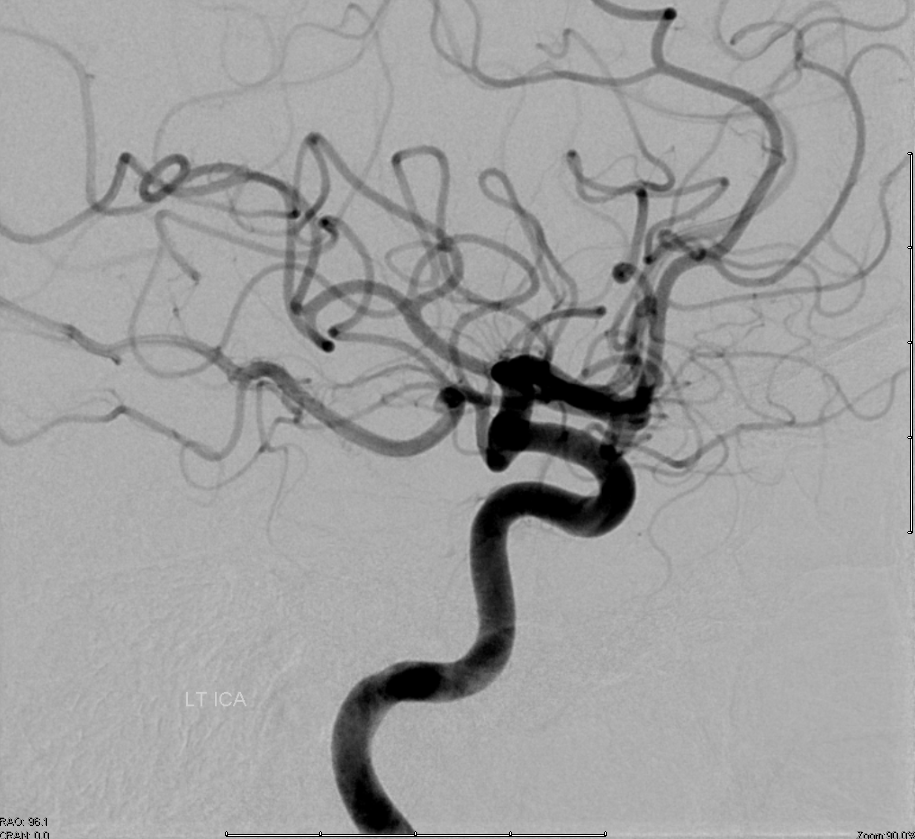
The second issue with ophthalmic segment — extending to the PCOM ostium as defined by Bouthillier — is the fact that, just distal to the ophthalmic ostium, the ICA typically gives rise to one or several superior hypophyseal arteries. These are widely held to play a role in pathogenesis of aneurysms — aptly called “superior hypophyseal aneurysms” which arise from there. I am not confident that all aneurysms originating from this area have such a vessel-based relationship — particularly the blister type. Regardless, it seems somewhat strange to say that a superior hypophyseal aneurysm is arising from the ophthalmic segment. Thus, we chose to separate this segment into distinct “ophthalmic” and “hypophyseal” types — the latter reflective of our belief that not all aneurysms of this area are necessarily “superior” hypophyseal.
The problem with our definition is that it requires establishement of a boundary, and admittedly a very arbitrary one, between the truncated ophthalmic and newly minted hypophyseal segments. Since the superior hypophyseal arteries are essentially angiographically invisible — being superimposed on the lateral projection upon the larger ICA trunk, and occasinally appreciated on the AP projection with some uncertainly — there is no clear place to draw an angiograhically demonstrable physiologic separation. Therefore, we opt for a pathologic one, defining the segment according to the aneurysm it contains — which linguistically is not a new development, since most operators, surgical and endovascular alike, already describe the aneurysms separately. This uncertainly mirrors the underlying trans-segmental nature of many aneurysms found in the area.
Aneurysms
The ophthamic aneurysms, even when relatively discrete, are very heterogeneous. The classic, superiorly-pointing one arises just distal to the ophthalmic ositum, or incorporating the initial, cisternal portion of the ophthalmic artery into its base. Others more broadly involve the ophthalmic artery, which arises from the body or dome of the aneurysm. Yet another kind grows from the lateral portion of the ICA at the level of ophthalmic takeoff — somewhat more rare given presence of the clinoid process there. A somewhat special type is one which arises medially from the ICA at the level of the ophthalmic — as it may in fact be a very proximal superior hypophyseal aneurysm, if such an artery happens to have a proximal origin. Finally, there are very many ones that are fusiform, proximal and distal to ophthalmic ostium. All of these have been sub-classified in various neurosurgical works, as morphology, origin, and projection of the aneurysm significantly affected surgical approach and associated issues/risks. From an endovascular standpoint, frankly, these issues are much less important. As treatment of carotid siphon lesions continues its overall shift towards endoluminal (flow diversion) methods, previously critical surgical and endosaccular distinctions are receeding in prominence. The technical issues which affect endoluminal methods — parent vessel configuration, access considerations, regional perforators — along with non-technical factors such as antiplatelet issues — drive treatment discussions, rather than strict aneurysm location, neck configuration, or morphology per se. The singular advantage of endoluminal treatment lies in its ability to address underlying carotid dysplasia by re-creating the deficient vessel wall.
Images of DSA and 3D-DSA, demonstrating a classic ophthalmic aneurysm, projecting upward from the ICA just distal to the typical intradural, superomedial origin ophthalmic artery.
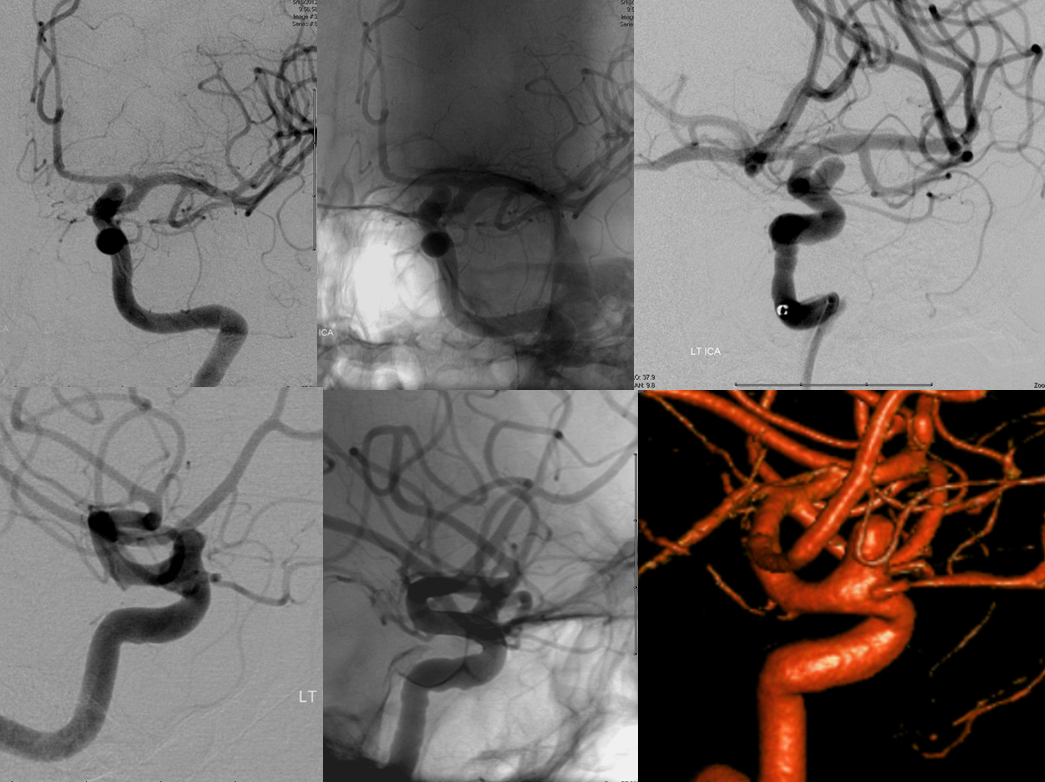
Superiorly projecting ophthalmic aneurysm
This medially-projecting aneurysm slightly distal to the ophthalmic ostium is the somewhat unclear kind, as it may be — and probably is — a superior hypophyseal type arising in association with a very proximal superior hypophyseal branch. In terms of endovacular treatment, the distinction is of little importance.
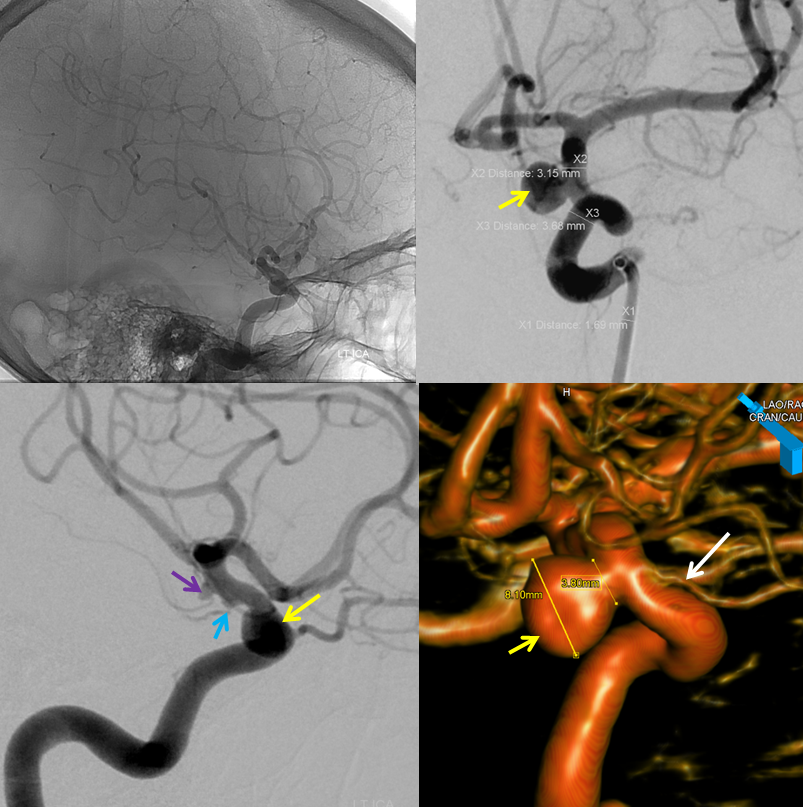
This is a typical dysplastic trans-segmental aneurysm which extends across a large swath of Bouthillier’s ophthalmic segment, and our ophthalmic-hypophyseal segments. Arthur Day called this type “Carotid Ophthalmic”. Whatever you call it, as long as the name brings up an image, it really makes no difference.
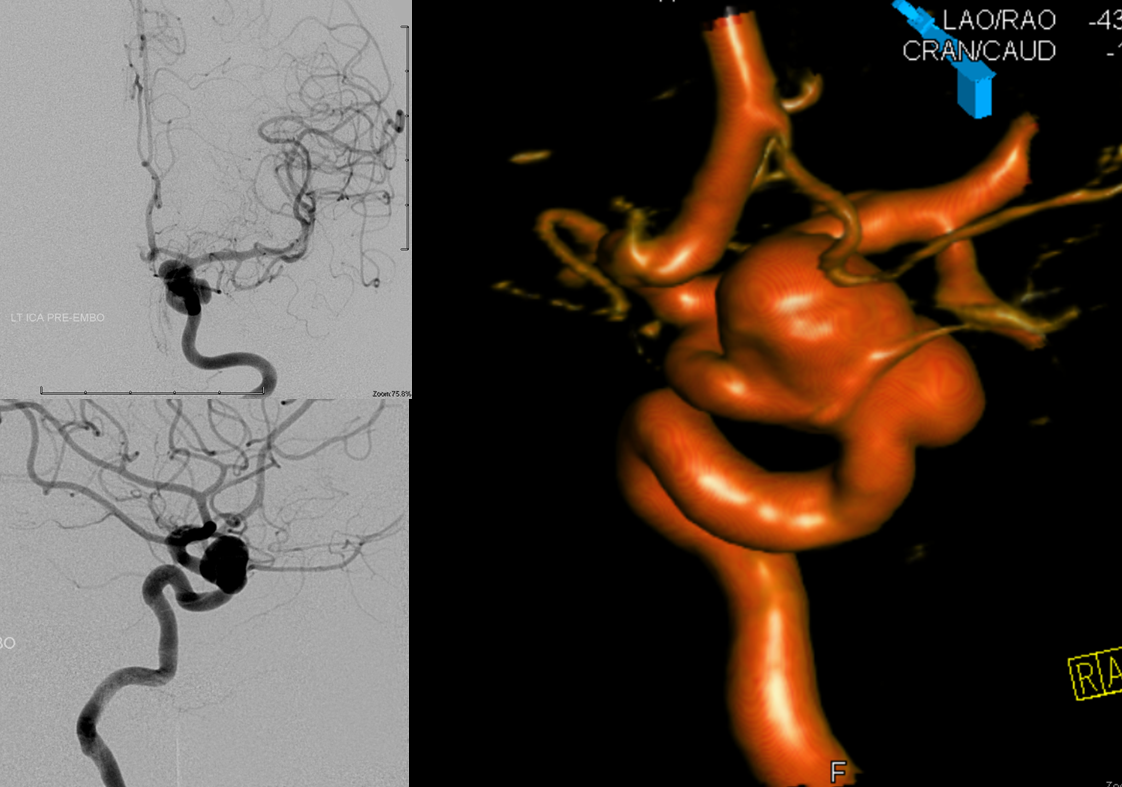
Stereo 3D-DSA images of another ugly, dysplastic ophthalmic-hypophyseal one. Notice the ophthalmic artery arising from the anterior aneurysm dome.
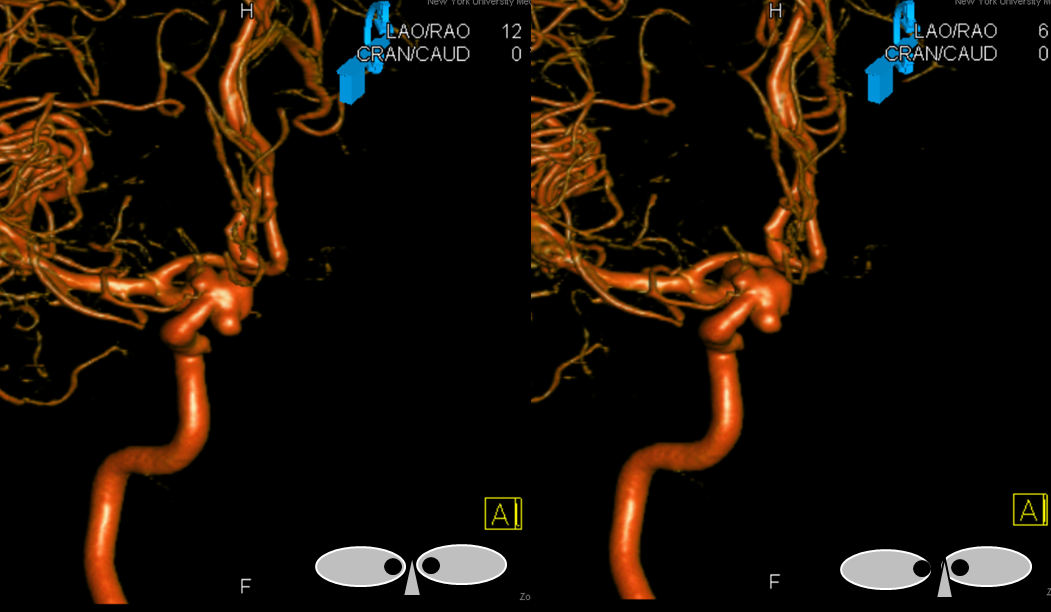
Images below are pre and post Pipeline embolization. Unlike in coiling, the optimal view for pipeline is one that shows the proximal and distal ICA “landing zones” of the device, rather than optimizing view of the neck. Bottom images 6 months post Rx show the occasionally encountered intimal hyperplasia. Notice also how the ophthalmic stays open with what now looks like a kind of “infundibulum”.
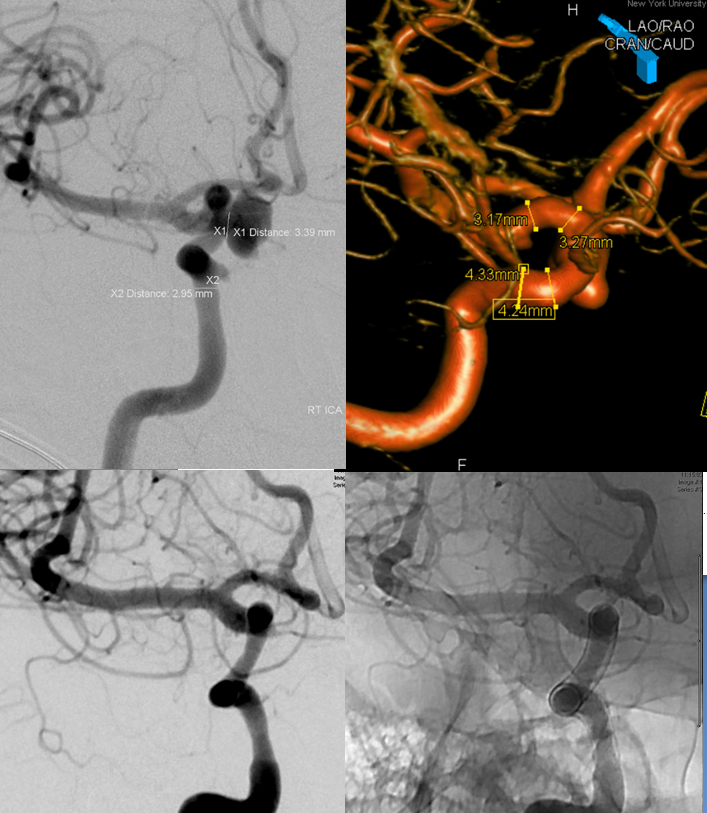
One more… Now did the ophthalmic ostium get there? By the aneurysm incorporating the native ostium on the medial ICA, and slowly expanding into the pituitary fossa The three bottom images are post PED placement.
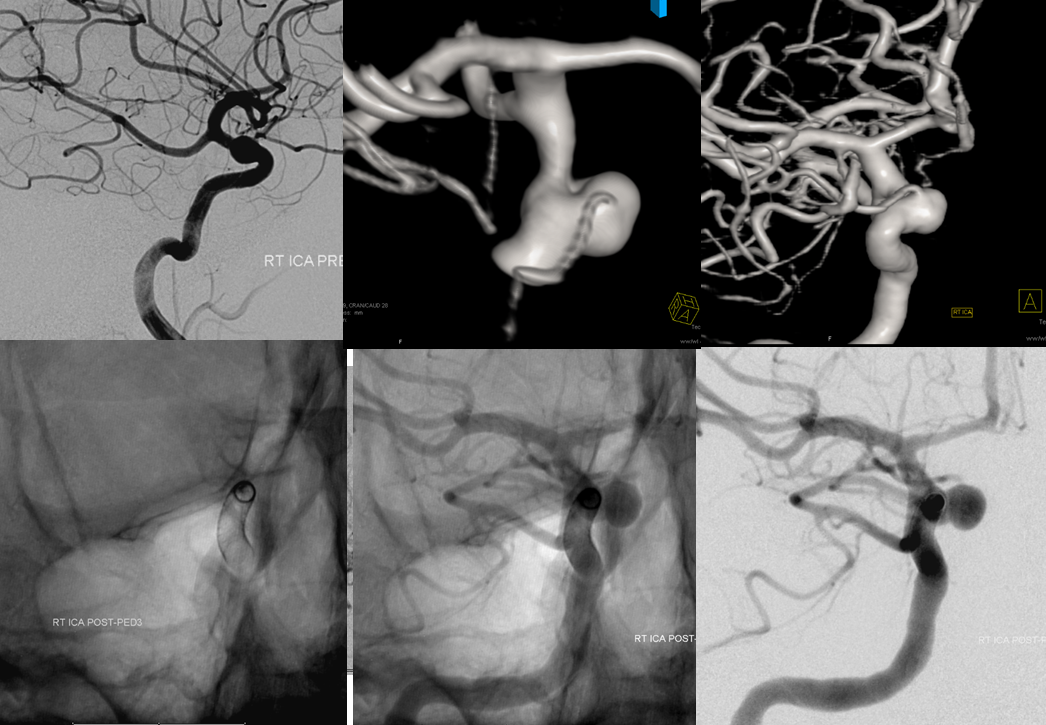
Hypophyseal Segment
Already discussed above in its relationship to the Ophthalmic segment, the hypophyseal segment extends from beyond ophthlamic ostium region to the PCOM. Admittedly, the boundary between ophthalmic and hypophyseal segments is nebulous, and not infrequently aneurysms span both. The percieved advantage is that the name specifically refers to the superior hypophyseal aneurysms which arise from the medial wall of the carotid, as well as to the infrequent ones which seem to have no relationship with any branch — the blister kind, specifically. The superior hypophyseal arteries arise from the medial or inferomedial part of the artery, notably supplying the hypophysis and, potentially, portions of the optic apparatus. The problem is that they are angiographically difficult to see — in the lateral view, they overlap with the body of the ICA, and so might be seen as a double density rather than a discrete branch. The frontal view is not particularly helpful in determining where exactly the artery comes from. They can arise quite proximally, almost at the level of the ophthalmic — such that a medially poining aneurysm arising at the level of, but separate from, the ophthalmic ostium may in fact be a superior hypophyseal kind. Since not all aneurysms of this segment are definitevely related to these arteries, the simple name “hypophyseal” seems accceptable. Blister aneurysms, infrequent, but as such often encountered at this segment, re probably dissecting in nature. They may be seeon on the superior or lateral walls of the ICA, away from the superior hypophyseal arteries. Treatment is rather difficult; there is no neck to clip or coil; near-term rebleed rates are high. Pipeline was used successfully on some occasions in those fortunate enough to survive initial SAH and subsequent antiplatelet state.
Frontal and lateral projection views of left ICA injection, showing an irregular, superolaterally -projecting hypophyseal segment aneurysm. Its relationship to the superior hypophyeal arteries is unclear. Notice that the ophthalmic artery arises more proximally than usual — likely extradural. Had it arisen from its usual location, this aneurysm would have been classified as “carotid-ophthalmic” by Rhoton, Day, or . Aneurysm orientation implies that a view from underneath the ICA (along the yellow arrow) would be most helpful in profiling the neck.
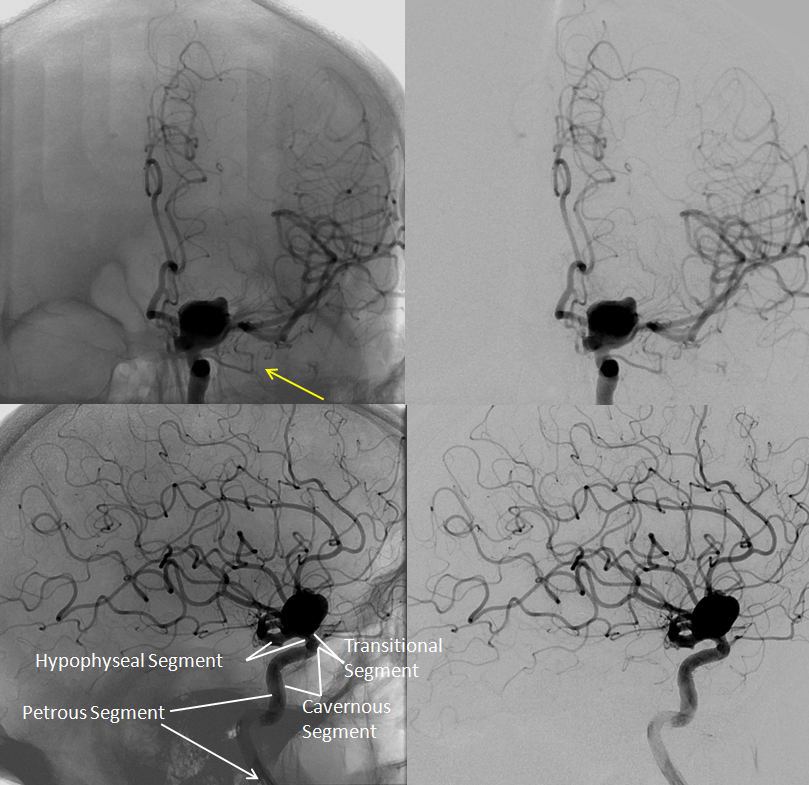
3D-DSA and DSA views in expected orientation working projection, placing the neck in profile and, more importantly, demonsrating proximal and distal ICA landing zones for Pipeline deployment. Image on the right shows the construct in place, spanning supraclinoid and ophthalmic segments. The proximal location of the ophthalmic is again emphasized.

This is a typical medially-projecting superior hypophyseal segment aneurysm; notice also a choroidal segment aneurysm.
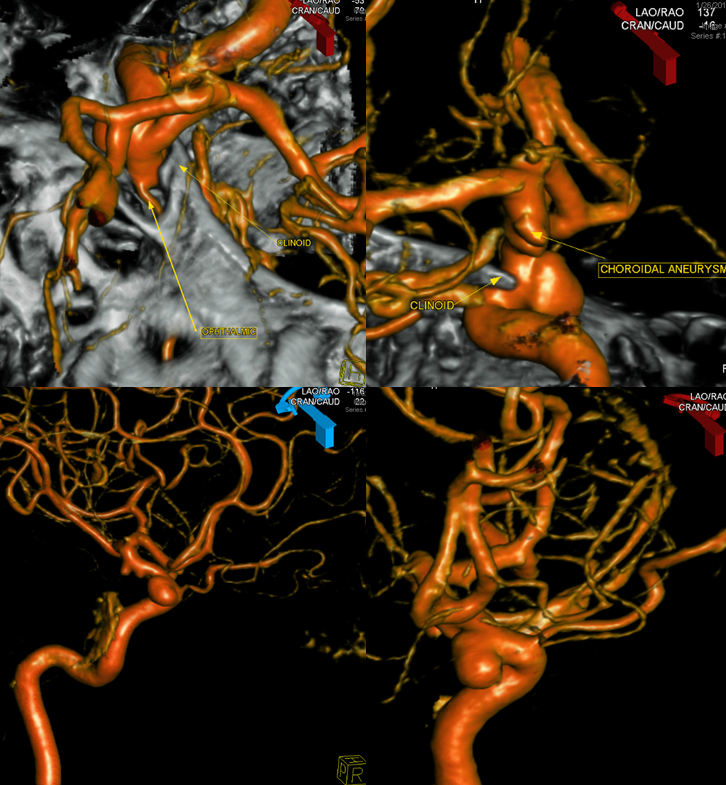
Status aneurysmicus — baseline dysplasia. Ophthalmic and hypophyseal aneurysms — or perhaps one common one. PCOM infundibulum, and a rare MHT infundibulum also.
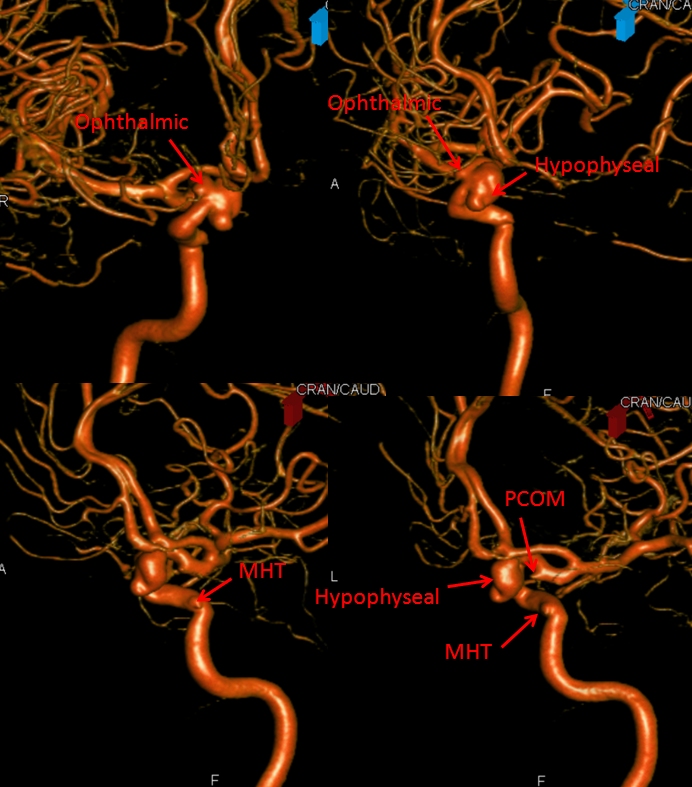
Blister aneurysm of the hypophyseal segment — these are the subtle ones. The days of angio-negative SAH, with subsequent discovery of an occult saccular aneurysm may be waning (though certainly not history). The blister kind is one where follow-up angio is key. For us, anything other than classic perimesencephalic pattern means two catheter angios — baseline and follow up.
On day presentation, there is impressive SAH. Day 1 angio shows very subtle spasm on the hypophyseal segment. Day 5 angio demonstrates much more spasm in the hypophyseal segment and proximal MCA/ACA (not shown). An oblique view of the hypophyseal segment uncovers the nasty, crater-like blister aneurysm.
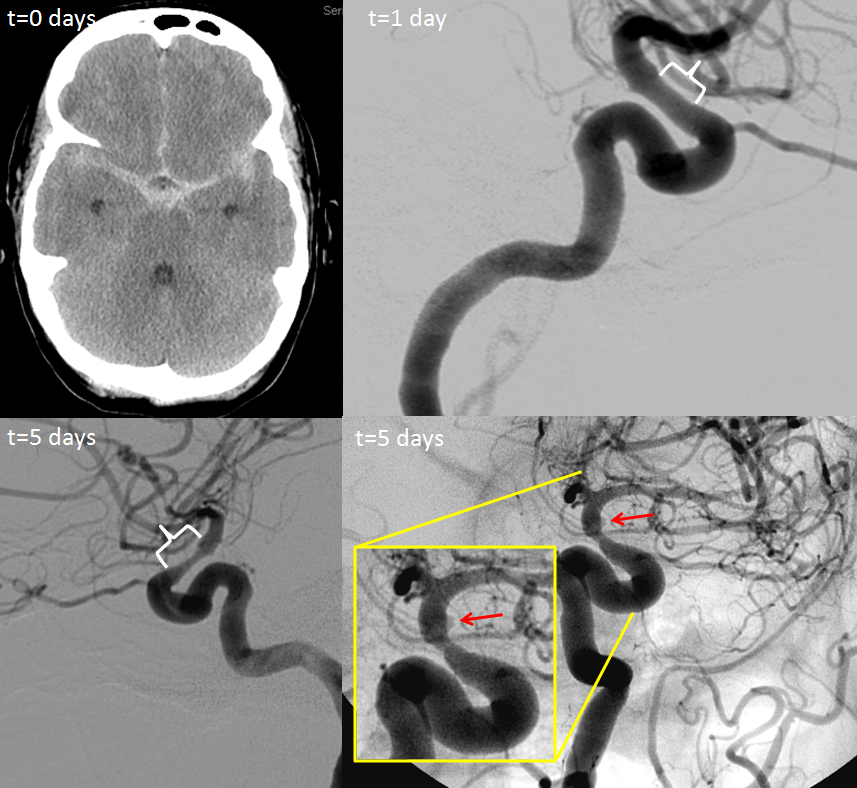
The patient was observed for additional 10 days, crash-loaded with plavix and aspirin on day 15 post SAH, and Piped on the following day. The ancient Bellevue machine does well, with external measurement devices. Three months later, the aneurysm is cured.
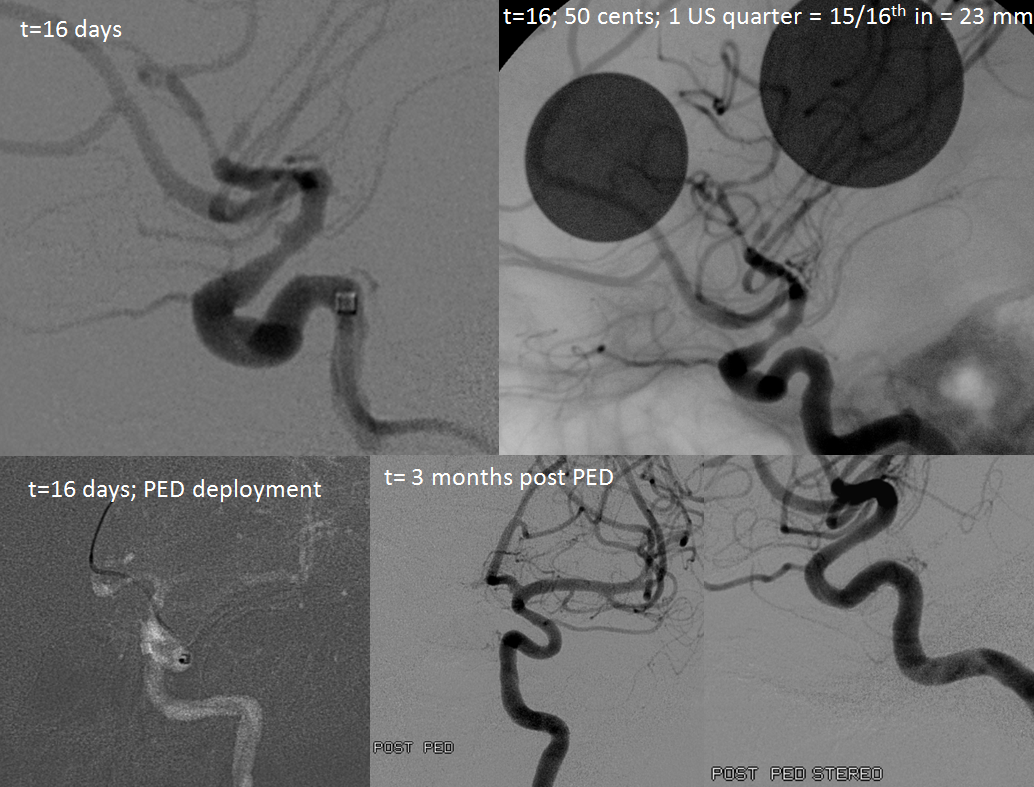
Paraophthalmic Segment

The more radical opinion, which we kind of like to endorse, is to united the above three segments (transitional, cavernous, and hypophyseal) into a single paraophthalmic segment. The reasons for this are several:
1) Our experience in reviewing tons of angiograms suggests that this segment is particularly susceptible to segmental dysplasia which gives rise to complex aneurysms that do not respect external boundaries, such as dural rings. It seems that there might be a pathophysiologic basis for considering this area as a single segment.
2) We find that inter-oberver correlation in terms of naming aneurysms of transitional, ophthalmic, and hypophyseal areas is quite low. In other words, people often disagree as to what to call a diven aneurysm, especially when discussions are held in a non-binding, informal format where everyone is entitled to their equal opinion. Granted, saying “paraophthalmic” does not mean much, but it sure streamlines things when statistical and research matters are discussed.
3) The most sensible solution to the whole dilemma of clinoid/transitional aneurysms is to consider them all as potentially intradural. As discussed above, currently available imaging modalities cannot visualize dural rings, nor estimate their integrity in case of adjacent disease. Only surgical exposure can give a definitive answer, and this is happening less and less around the carotid siphon.
4) While surgical considerations for treatment of clinoid, ophthalmic, and hypophyseal aneurysms are vastly different, their endovascular issues are, if you think about it, are quite similar. Endoluminal “flow diversion” tools, when used in this area, tend to span all three segments. Even coiling considerations, adjunctive or not, is not so different between a transitional and superior hypophyseal aneurysms. Those incorporating the ophthalmic may be unique, but even that is not the same as, say, treating a choroidal aneurysm.
Anyway, a little digression from the usual matter-of-fact neuroangio. But its worth thinking about, believe me, as we move into the PCOM segment.
PCOM Segment
The communicating segment is defined by Bouthillier as extending from the PCOM to carotid bifurcation, thus including the choroidal artery and ICA distal to it. For the purposes of this discussion, however, we define the PCOM segment as extending from the PCOM to the Anterior Choroidal ostium only, referring to distal ICA separately under “choroidal” and “terminus” segments. As you know, strictly speaking, PCOM aneurysms are truly ICA aneurysms arising at the origin of the PCOM, but we are not so pedantic. On the other hand, to say that a choroidal aneurysm arose from the communicating segment is kind of awkward. Besides, the clinical presenation, rupture risk, and treatment considerations for choroidal aneurysms are quite different from PCOM aneurysms.
Classically, PCOM aneurysms arise just distal to PCOM ostium, from the posterolateral ICA wall, and initially projects posterolaterally. Lateral-pointing aneurysms may impact the third nerve, with the classic presenation of pupil-sparing CN III palsy. PCOM aneurysms have notoriously high recurrence rates following endosaccular coiling. Sometimes, the better part of valor is to take the whole PCOM, provided no perforators are present and a good P1 segment is available, if coiling continues to be chosen. Recurrence can also be treated by endoluminal methods (flow diversion). It is important to make a distinction between PCOM and anterior choroidal segment aneurysms, particularly when parent vessel sacrifice is performed (more often surgically); this is not always clear, especially (I believe) on CT angiographic studies of patients with hypoplastic PCOMS.
A treacherous, double-bubble PCOM aneurysm, arising from a fetal disposition vessel.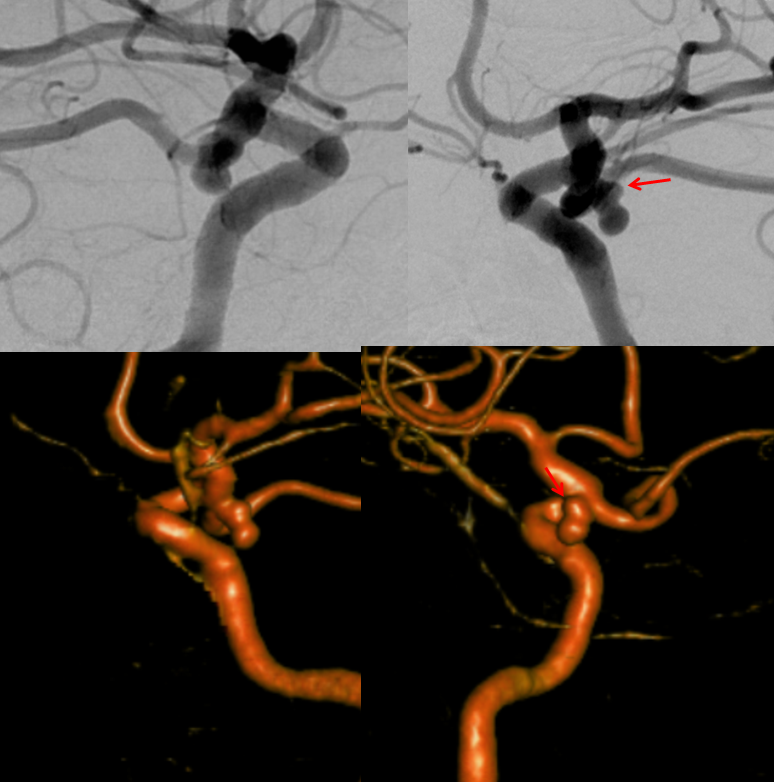
Anterior choroidal segment — ICA adjacent to the choroidal artery. Issues described above. Unlike the PCOM, which may be deliberately closed with clips or coils to cure an associated aneurysm in most cases, the choroidal should better be kept open. Relative dominance of choroidal perforators, which are in equillibrium with terminus segment and M1/A1 perforators, defines the clinical and geograpic extent of infarction in cases of choroidal occlusion (see Anterior Choroidal Artery page). In the setting of a developmentally hypoplastic PCOM, it is particularly important to decide whether a given aneurysm is PCOM or choroidal. I suggest that a catheter angiogram, rather than cross-sectional studies, is the best way to make this determination. Morphology helps, also, as choroidal aneurysms tend to project inferomedially.
Terminus Segment
Beyond choroidal ostium, a short Terminus segment of the ICA leads into the carotid bifurcation. Perforating branches may arise from this very distal ICA, tranversing the anterior perforating substance to end in the hypothalamus, mesial basal ganglia, and internal capsule. They are in hemodynamic balance with proximal perforators from the adjacent anterior choroidal artery and the lenticulostriate group, such that hypoplasia of choroidal origin perforators is usually accompanied by prominence of the same territory perforator from the immediately adjacent terminal ICA — this configuration is mistakenly called “duplicated” anterior choroidal (erroneous on embryologic basis, as only one anterior choroidal artery — the one supplying the choroid itself — is encountered). The same ICA and choroidal perforators play a prominent role in reconstitution the MCA, via the lenticulostriate group, in setting of Moya-Moya (below).
Frontal and lateral projection DSA views of left ICA injection, demonstrating typical puff of smoke Moya-Moya appearance, achieved by reconstitution of the MCA via anterior choroidal (purple arrow) and terminal segment (white arrow) perforators though the MCA lateral lenticulostriate group (black arrows). Notice proximal origin of the ophthalmic artery (distal cavernous or perhaps transitional segments) and a hypertrophied recurrent meningeal branch of the ophthalmic artery (yellow)
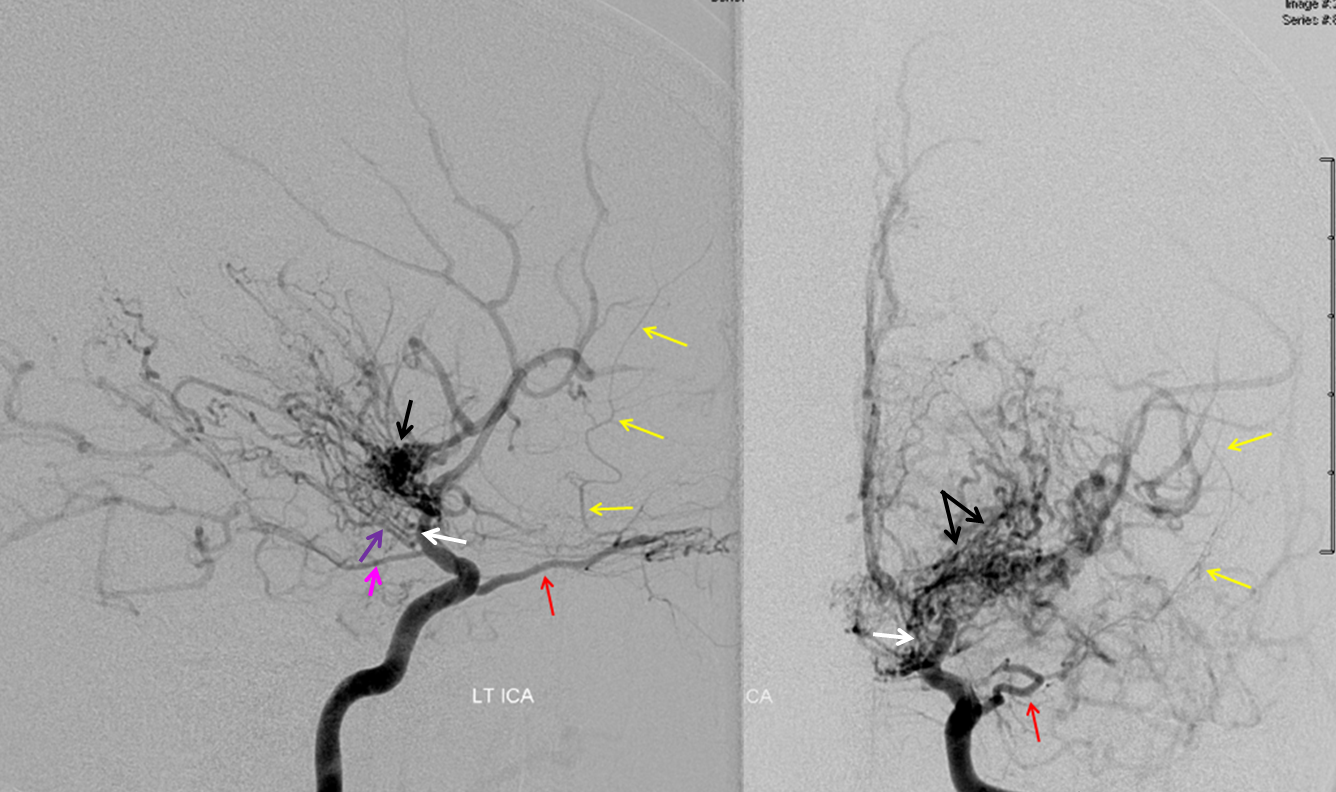
At the top of the terminal segment, the ICA finally bifurcates into middle and anterior cerebral arteries. Aneurysms of this segment tend to project in the direction of the terminal ICA — superiorly from the bifurcation. They are relatively uncommon — perhaps less common than the hemodynamic theory of aneurysm formation at major branchpoints might suggest.
Terminus aneurysm asymmetrically involving the A1 segment. Notice a small PCOM one also. This kind may be treated by coiling off the PCOM ostium, seeing the well-developed P2 segment, which implies presence of a robust P1 segment.
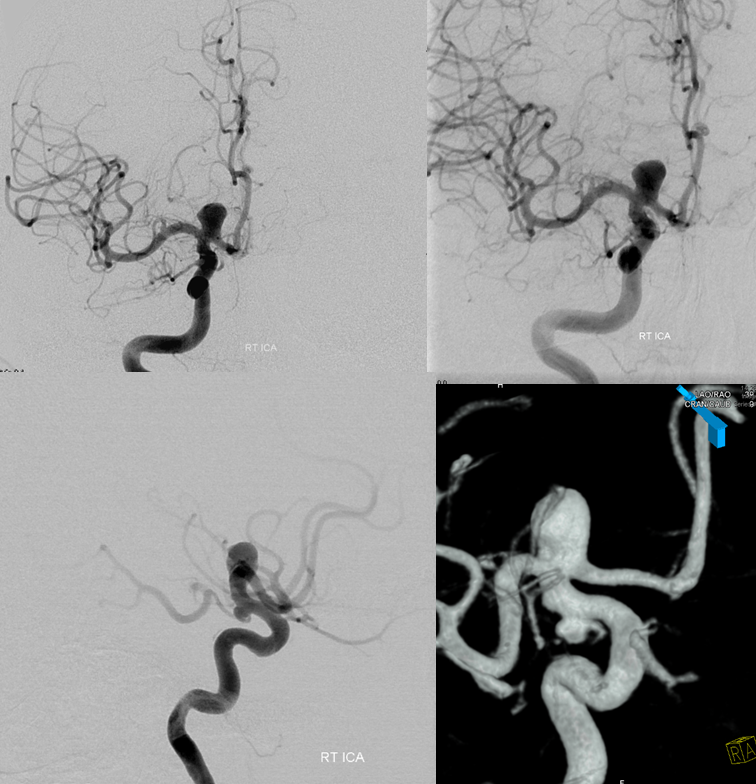
Summary: to be continued and updated, as comments and complaints arise.
Contacts: You can contact me via the Contact Us section or by calling the office: 1-212-263-6008
Resources:
Surgical anatomy — Albert Rhoton’s superb works. http://www.ncbi.nlm.nih.gov/pubmed/12234448
Barrow Quarterly excellent articles on relevant anatomy, available free of charge. http://www.thebarrow.org/Education_And_Resources/Barrow_Quarterly/205270
Many others — if you are a surgeon, you know. If not, ask one.
ICA classification systems:
Bouthillier’s landmark article: http://www.ncbi.nlm.nih.gov/pubmed/8837792
Ziyal — Proposed classification of segments of the internal carotid artery: anatomical study with angiographical interpretation http://www.ncbi.nlm.nih.gov/pubmed/15849455
Arthur Day: http://www.ncbi.nlm.nih.gov/pubmed/2324793
Barrow Quarterly:
http://www.thebarrow.org/education_and_resources/barrow_quarterly/204768
http://www.thebarrow.org/education_and_resources/barrow_quarterly/205264
http://www.thebarrow.org/Education_And_Resources/Barrow_Quarterly/205270
Good luck
